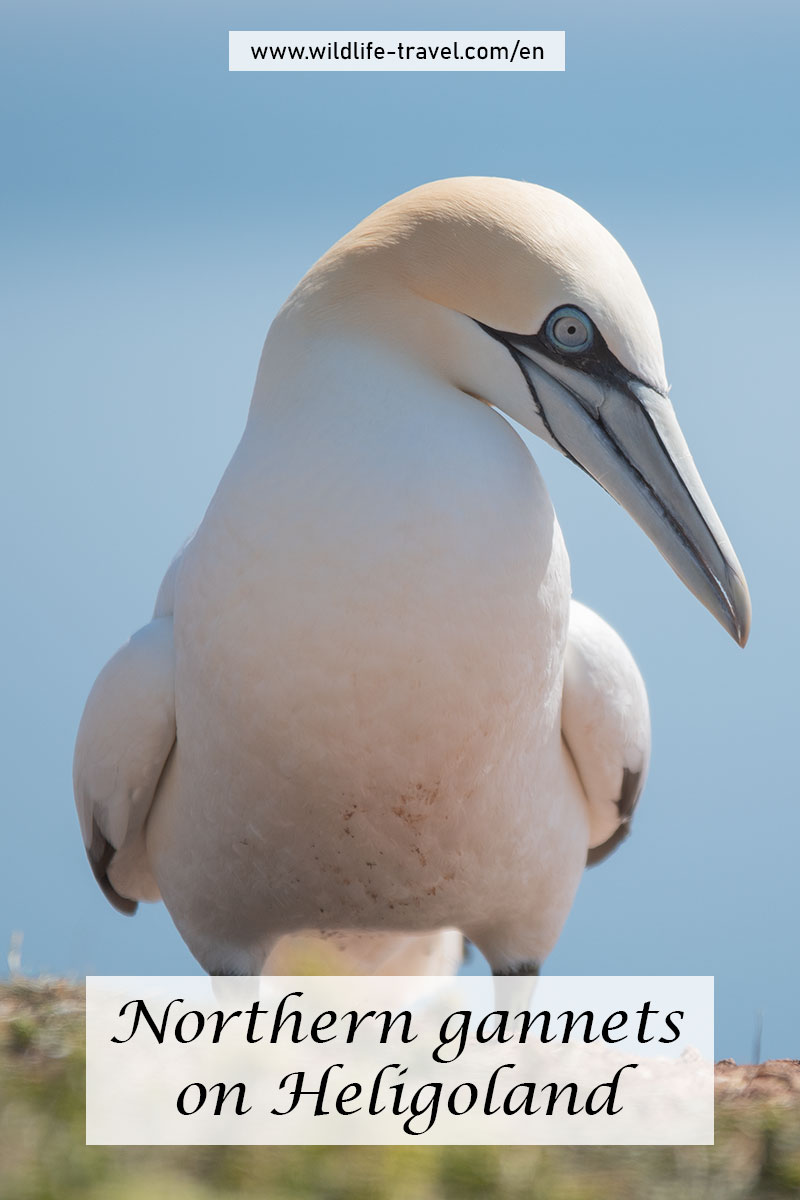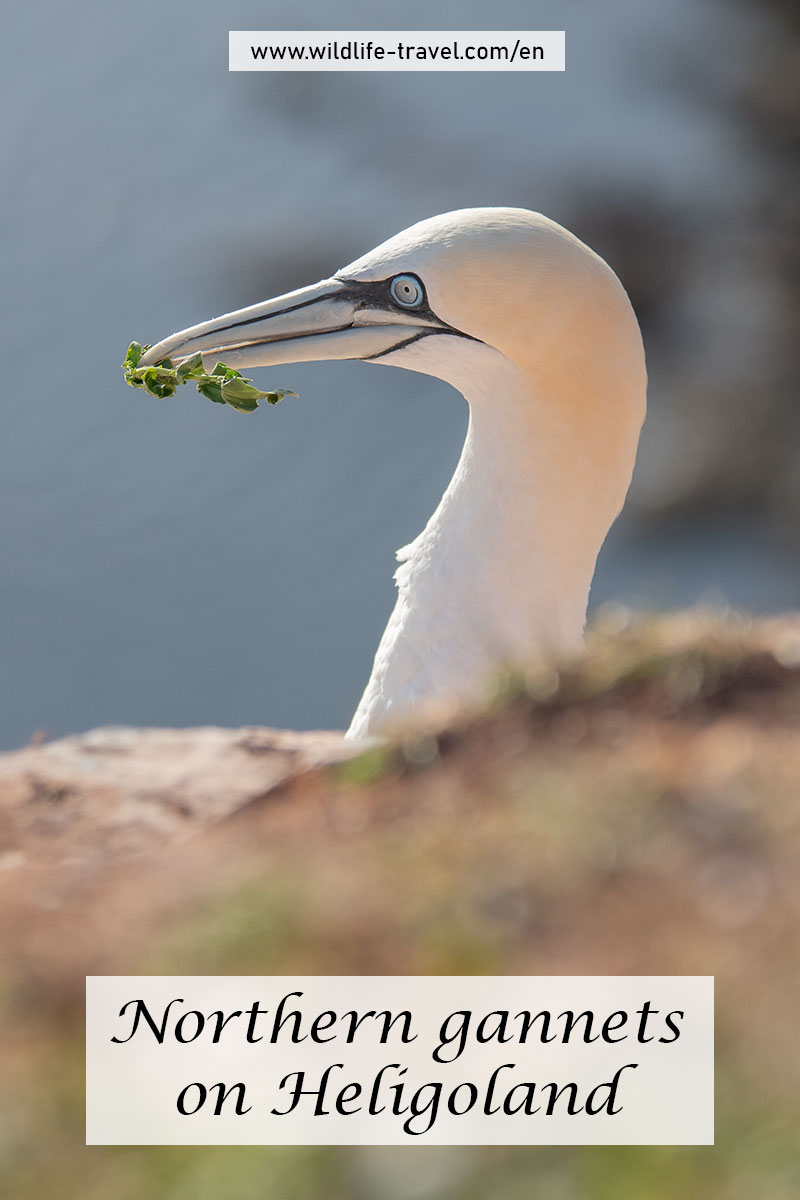Northern gannets breed on Heliogland every year from March to October on the Lummenfelsen and the close-by Tall Anna. They are colony-breeding birds and there is no other place in Germany where northern gannets breed. In this blog entry I write more about my four-day trip to Heligoland and my encounters with these sea birds and other wildlife like harbor seals.
Heligoland in spring
A colony of northern gannets at the Lummenfelsen. Sunbathing harbor seals at the beach on the Helgoländer Düne. But also astonishing sunsets to admire. And just a couple of days far away from a city. Just what I was looking forward to at the end of May. I knew Heligoland already, but not in May. Due to the Coronavirus pandemic, however, I was not sure this time about my travels. Should I go? As they had relaxed some of the restrictions to minimize the distribution of the Coronavirus just a few days before, I was indeed quite unsure.
Anyway, at the end I ventured forth.
I’m sure that I have experienced Heligoland in May in a very unusual period of time. Probably, the mainland of Heligoland and its neighboring island - the Helgoländer Düne - would have been more crowded with people if there wouldn’t have been so many restrictions due to the pandemic. However, in this way, I could have some very nice and relaxing days on Heligoland to observe northern gannets and harbor seals without too many people around. I also could explore the beautiful landscapes on Heligoland in a quiet and relaxing way.
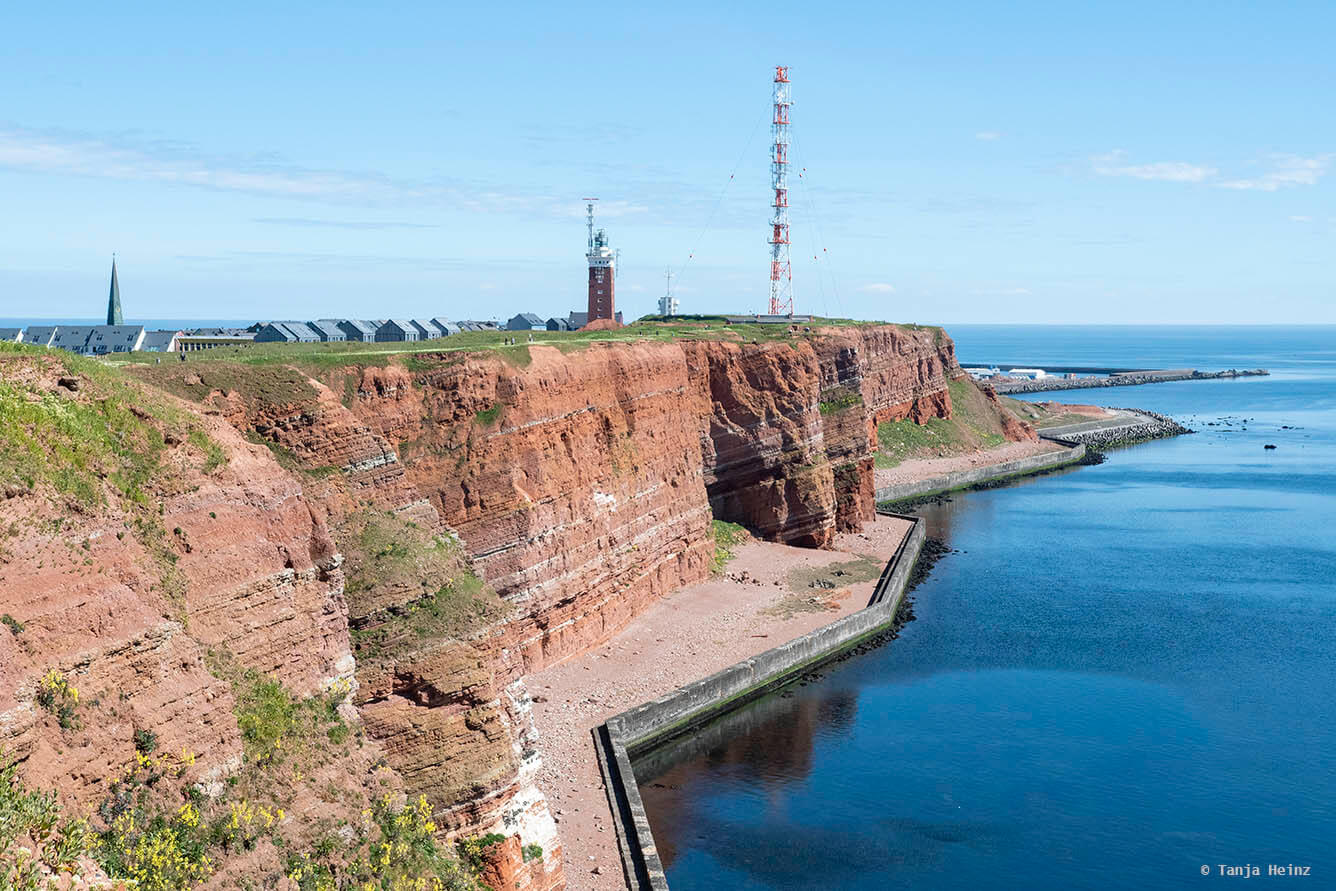
Tip: I have booked accommodation at the beginning of February, as I traveled to Heligoland on a long holiday weekend. As Heligoland is a popular island for holidaymakers, I decided to book that early. In that moment I did not expect so many restrictions due to the Coronavirus pandemic. However, in pandemic-free times, try to book as early as possible, if you decide to visit Heligoland on a long weekend.
As mentioned, for me it was not the first time visiting Heligoland. Although Heligoland has a size of only about four square kilometers, and thus, is quite small, wildlife changes over the seasons and you can expect to see different wildlife in spring, summer, autumn, or winter.
And this is the reason why I wanted to travel to Heliogland in May again.
On my last visit I went to Heligoland in winter as I was looking for grey seals, because from November to January moms give birth to their young on the beach of the Helgoländer Düne.
In spring and summer, the Lummenfelsen is probably the main attraction for many nature lovers, as thousands of sea birds gather around these cliffs.
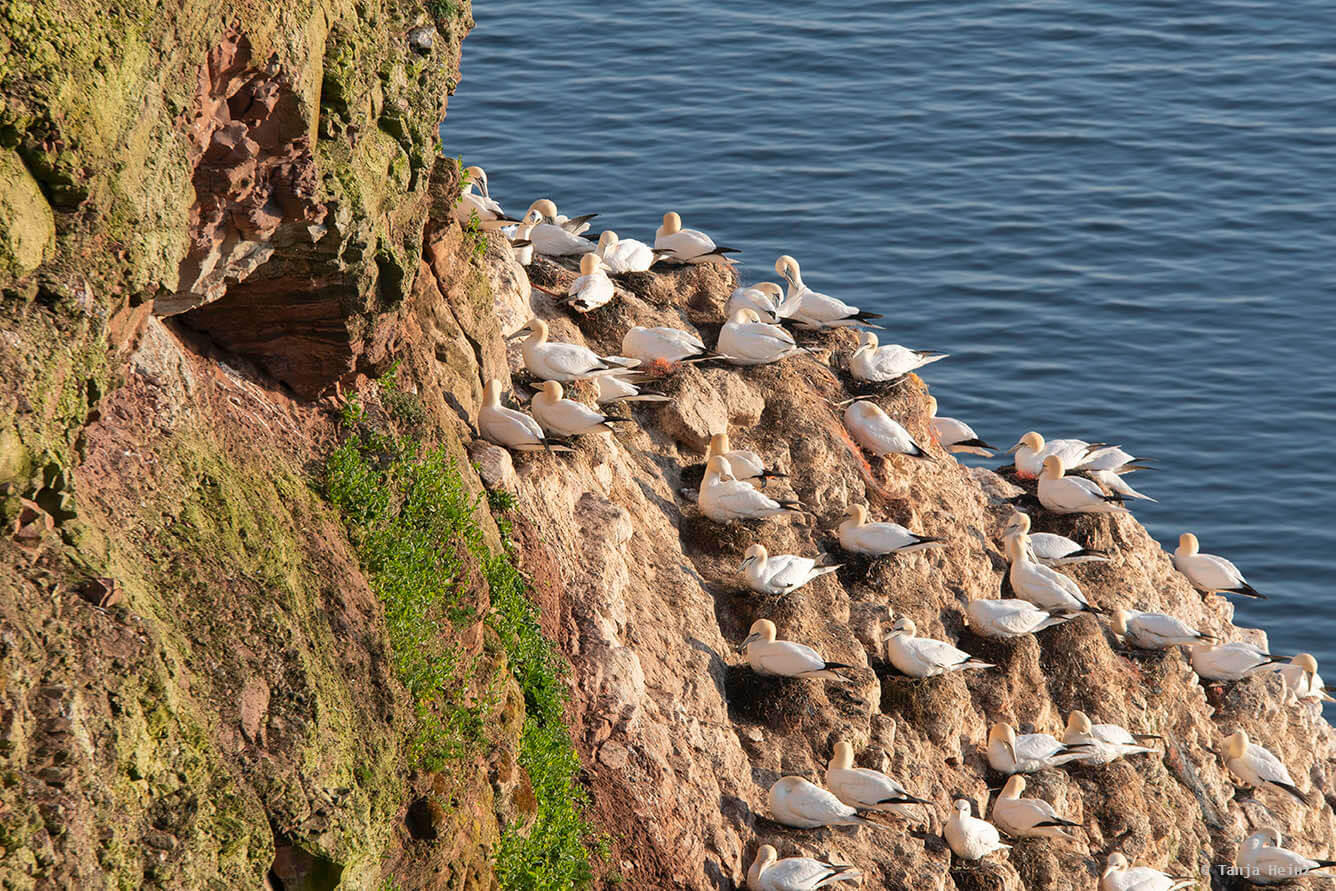
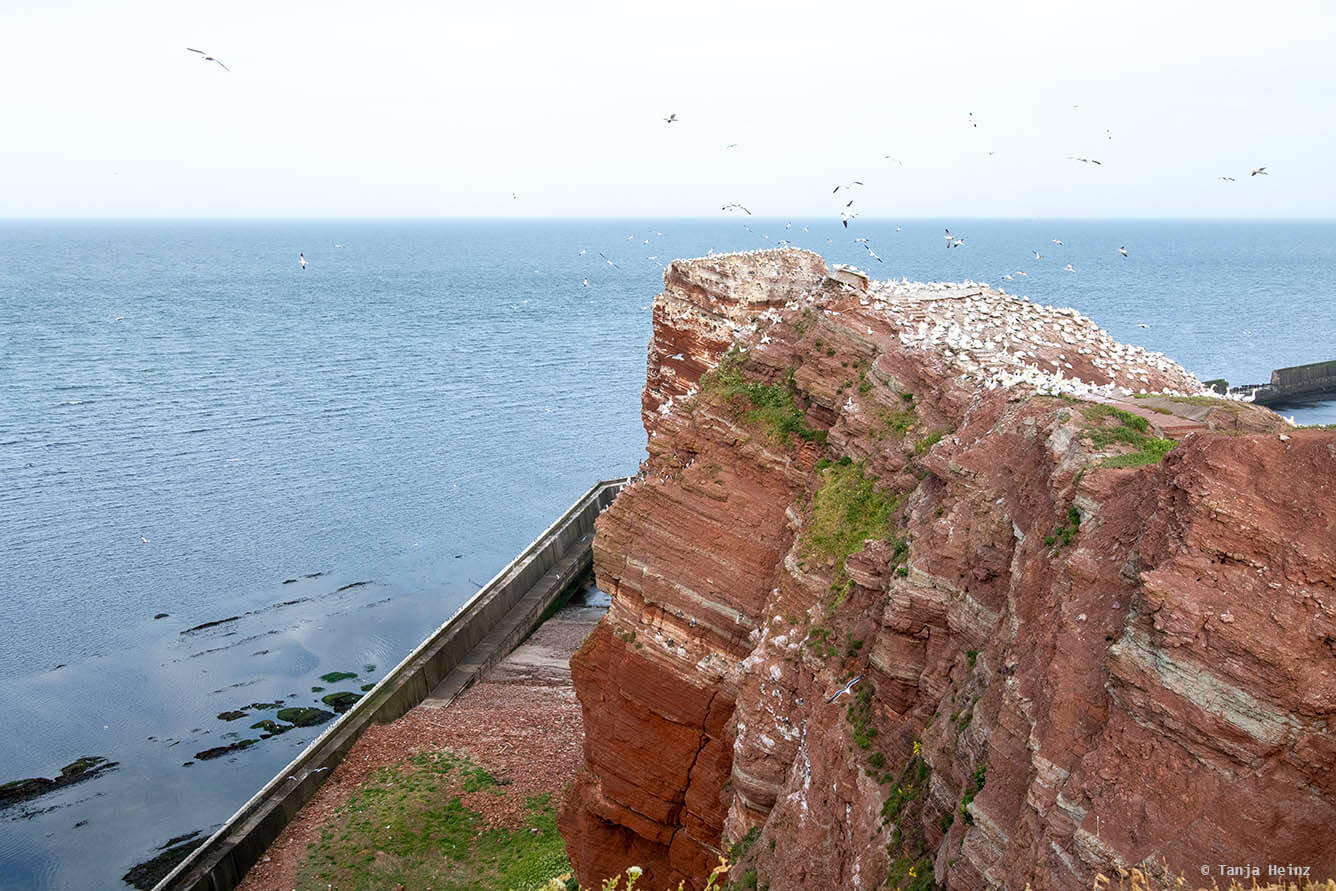
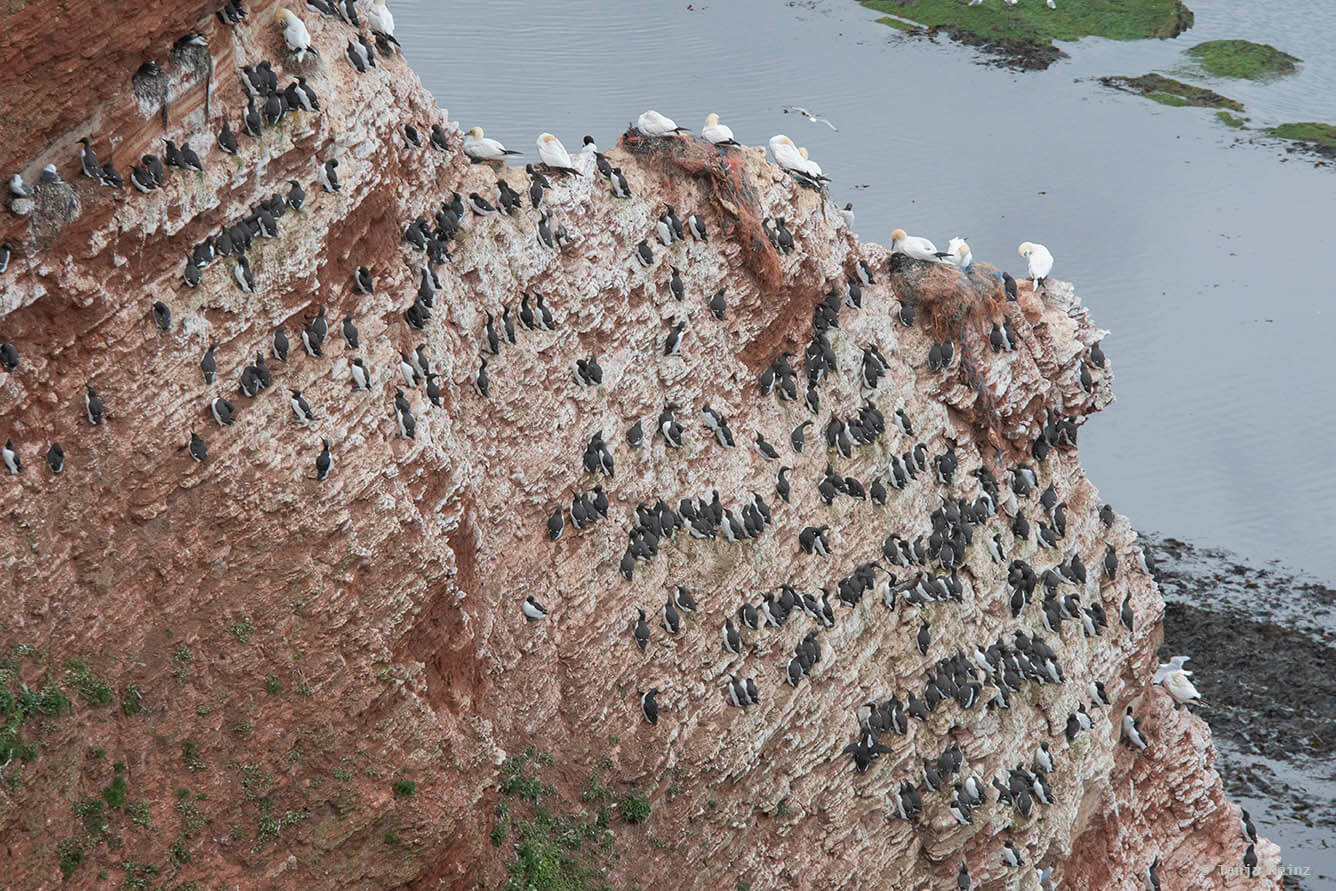
The Lummenfelsen (Lummen: "guillemots", Felsen: "cliffs") is one of the two nature reserves on Heligoland. The cliffs owe their name to the common guillemot that breeds on the Lummenfelsen. Tall Anna (German: "Lange Anna") - a 47-metre free-standing high rock column - is Heligoland’s landmark and just next to the Lummenfelsen.
Did you know? The Lummenfelsen is the smallest nature reserve in Schleswig-Holstein. With an area of about 1 hectare, it is furthermore one of the smallest nature reserves in Germany.
Both Tall Anna and the Lummenfelsen are used as a breeding site by thousands of sea birds. Most birds around the cliffs are not only common guillemots, but also northern gannets and black-legged kittiwakes. Vigilant bird watchers might also find razorbills, northern fulmars or herring gulls among all those many birds around the cliffs (more about all these birds on Heligoland further below in the next paragraphs).
The Helgoländer Felssockel (Felssockel: "bedrock") is another nature reserve on Heligoland located just next to the Lummenfelsen and Tall Anna.
On a beautiful day, you get some nice views onto it.
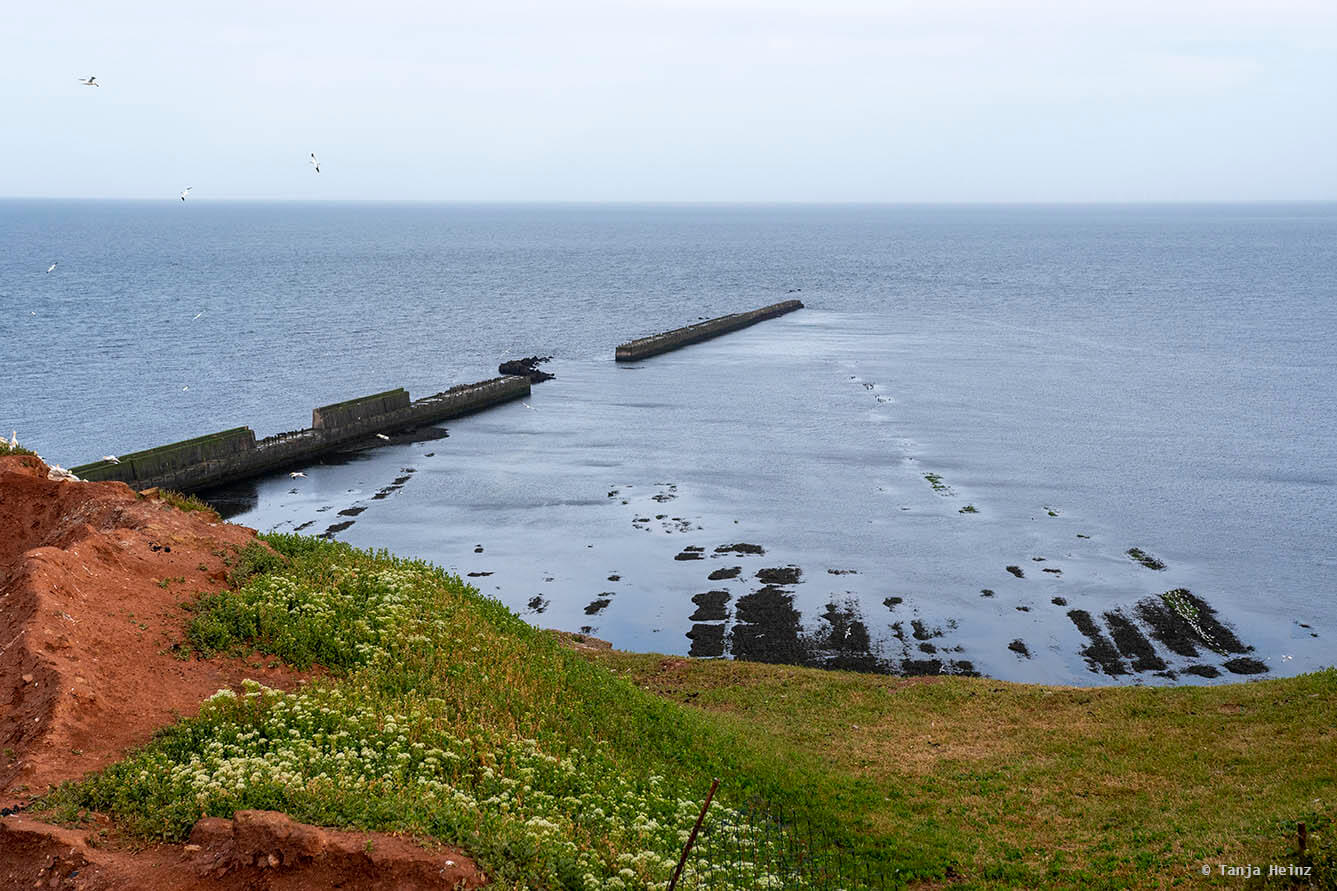
While the Lummenfelsen is the smallest nature reserve in Schleswig-Holstein, the Helgoländer Felssockel is the largest nature reserves in the state. With an area of more than 5.100 hectares, the nature reserve is divided into two subareas around the mainland of Heligoland and the Helgoländer Düne.
Along the path on the Upper Land (German: "Oberland"), you will get some information about the Helgoländer Felssockel.
The bedrock of the Helgoländer Felssockel can reach 48 meters in depth. Most parts of the bedrock - the rocky reef (German: "Felsriff") - is under water. But other parts in the northwest just off the mainland is exposed to the tides, and thus, may dry between the floods. This part is called the "Felswatt" (Fels: "cliff"; Watt: "tideland"). Algae and other marine organisms, that are adapted to these harsh environmental conditions, have colonized those cliffs and stones of the Felswatt.
Information: Animal organisms that are adapted to those harsh environmental conditions are, for example, sea anemones, poriferans, or bryozoans. They have adhesive organs which prevents them from being washed away by the flood. Barnacles, in contrast, form a calcareous shell which protects them from drying out.
The nature reserve of the Helgoländer Felssockel extends to the Helgoländer Düne. The Helgoländer Düne is an important habitat for grey and harbor seals.
On the Upper land it is possible to get a nice view onto the Helgoländer Düne.
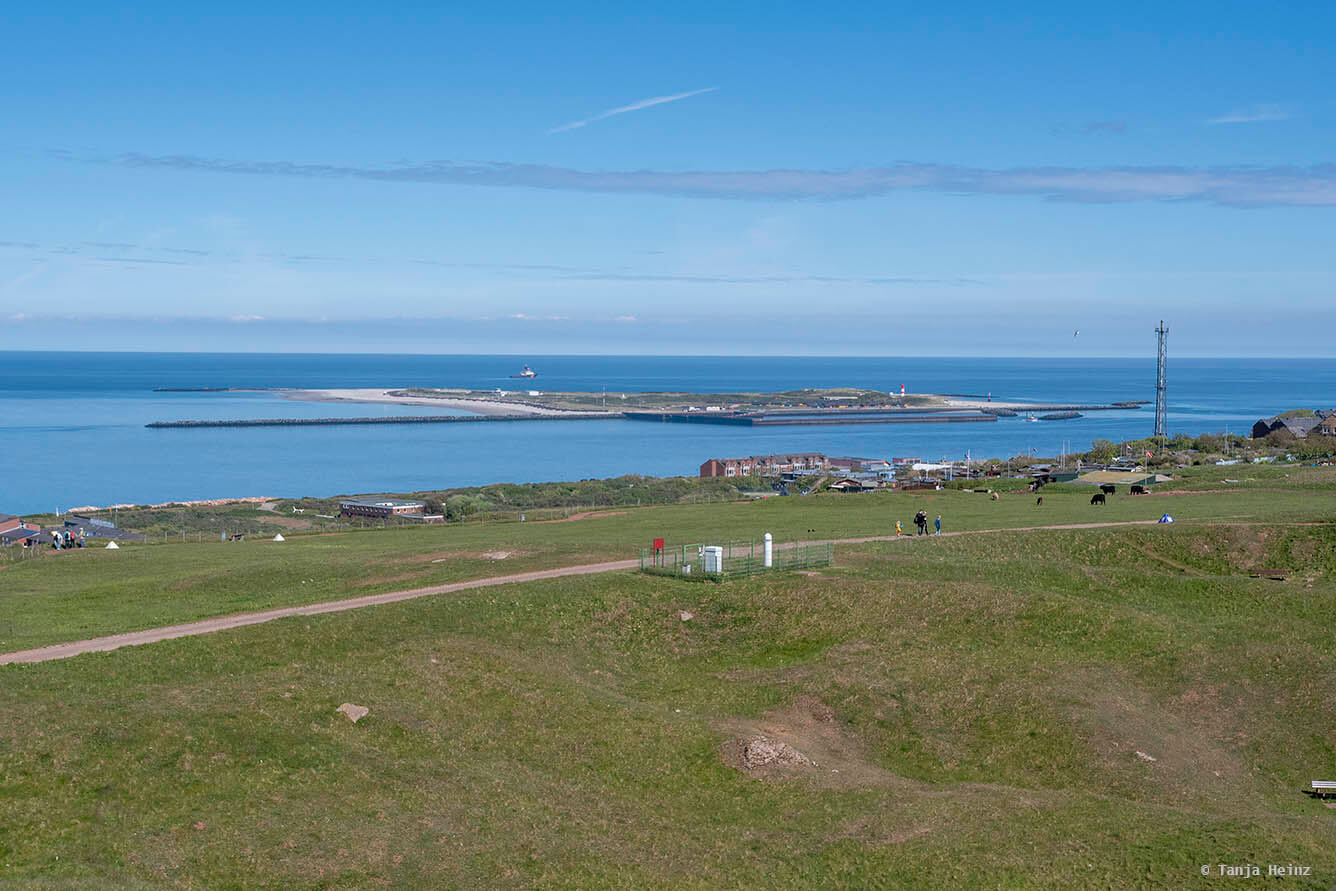
As I was so excited to see the northern gannets, I headed to the Lummenfelsen straight after my arrival on Heligoland. A pleasant breeze on the Upper Land let me enjoy not only the birds, but also the landscapes around. Lush green meadows and pleasant spring air made me feel lighter. Forgetting all the recent news and changes.
But I was not the only person close to the Lummenfelsen and the Helgoländer Felssockel.
Some people passed the birds. Strolling around. Talking, laughing, or just enjoying the warmth of the sun.
Others made themselves comfortable in one of the sunbeds in the middle of the meadows.

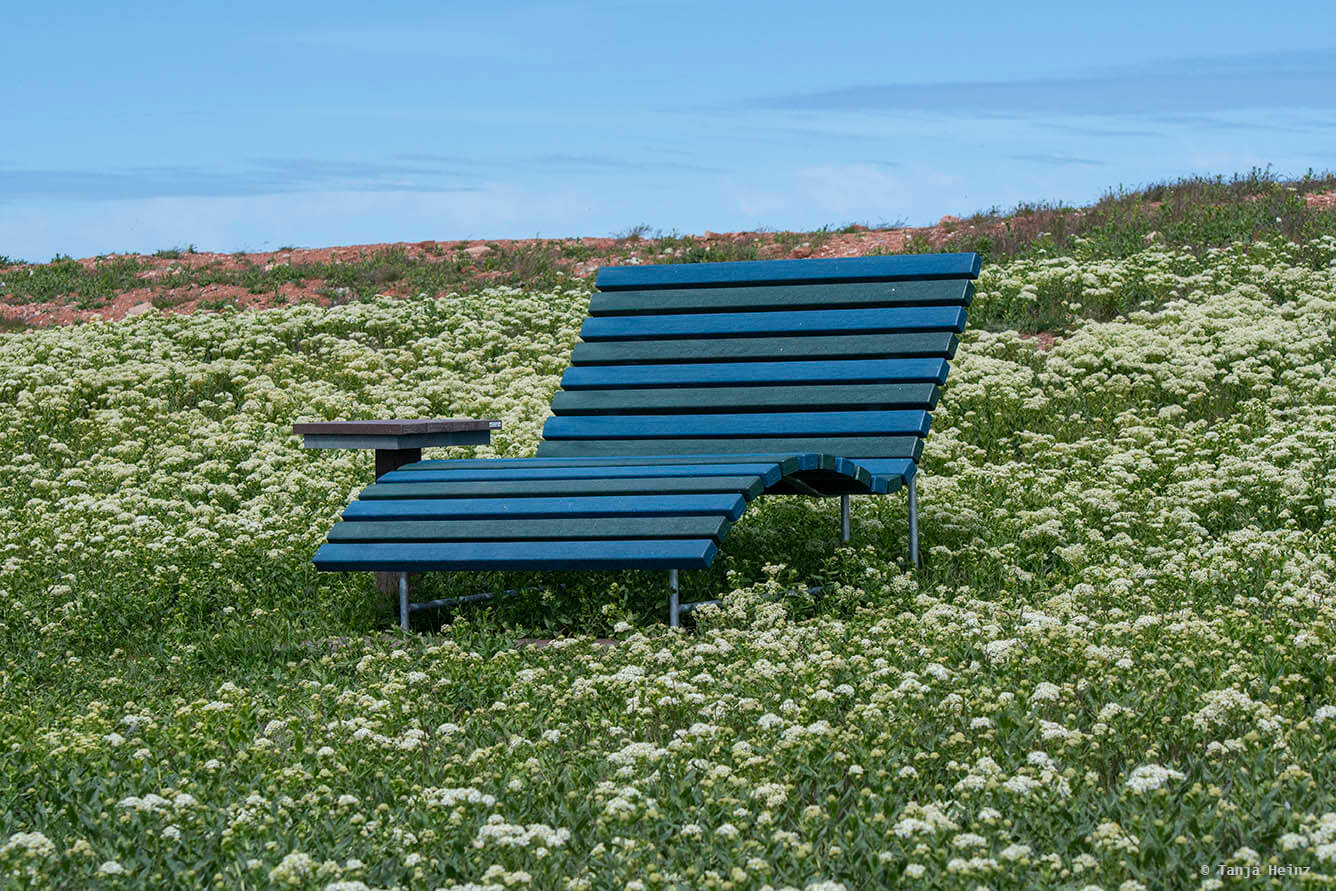
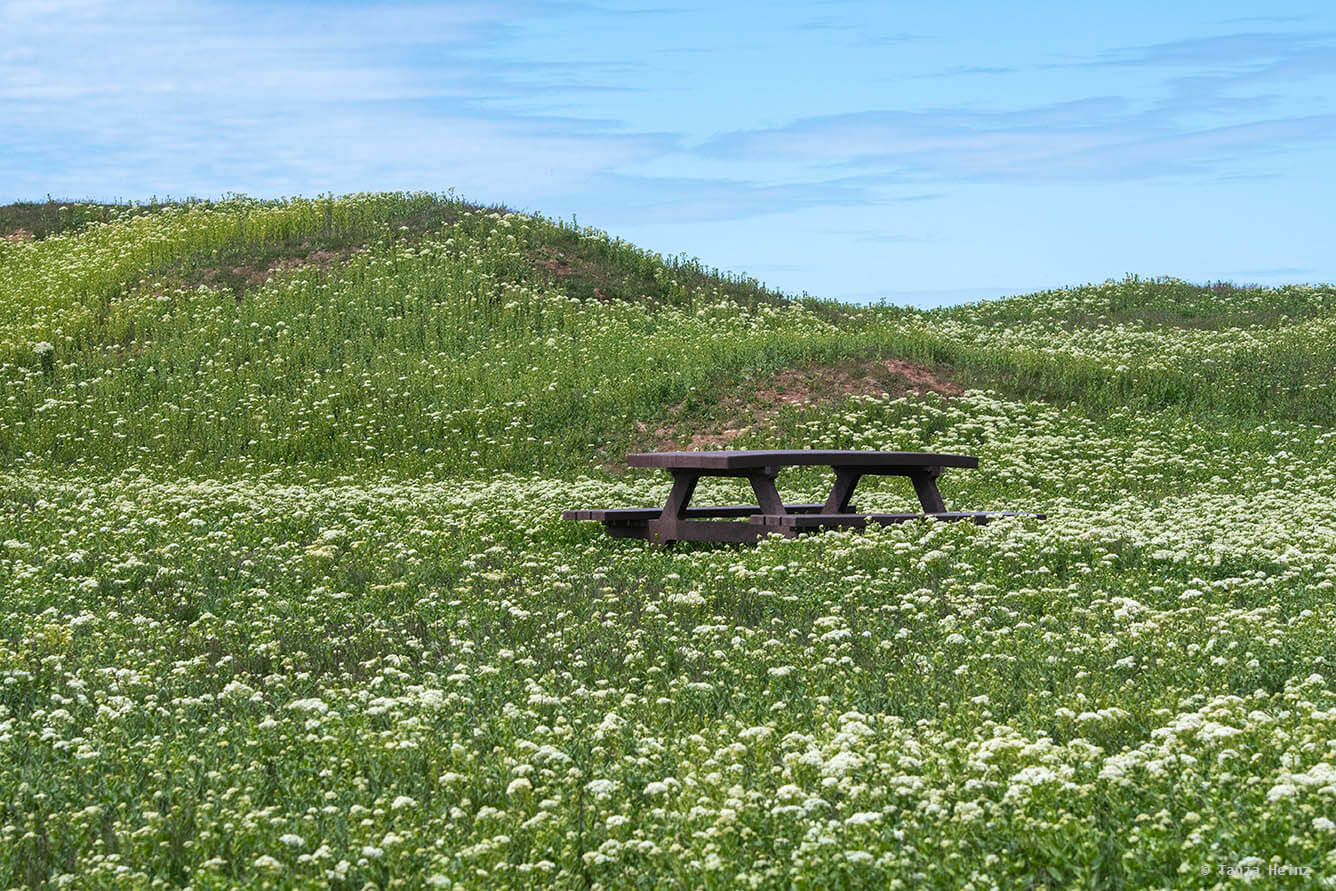

One girl was cuddling one of the sheep.
Why are there sheep on the island? Are they on the island to keep the meadows short on a biodiversity-promoting way? Like the ones on the Tempelhofer Feld in Berlin?
I don’t know and I could not find any information about that, but I watched them. Some sheep were with offspring. Others without.

I took my time.
I had all the time in the world.
When I visited Heligoland in winter I had something like a "daily routine" during the days of my stay. In winter, I went to the Helgoländer Düne early in the morning to stay there until midday/afternoon. In the evening I stayed in my comfortable accommodation.
Tip: If you want to plan your day according to sunrise and sunset, check the following website: Sunrise and Sunset. You can also use an app on your smartphone to get the information. On the days of my visit the sun was rising at about 5:15 a.m. and setting at about 9:30 p.m.
In May, my days looked slightly different. The days were much longer. As I wanted to visit both the Lummenfelsen and the Helgoländer Düne early in the morning at least once, I did not establish a regular timetable. On one morning I went to the Lummenfelsen. And on the other morning I went to the Helgoländer Düne. But on all days I went to see the sunset close to the Lummenfelsen.
Although it was raining on one afternoon, all sunsets were incredibly beautiful.
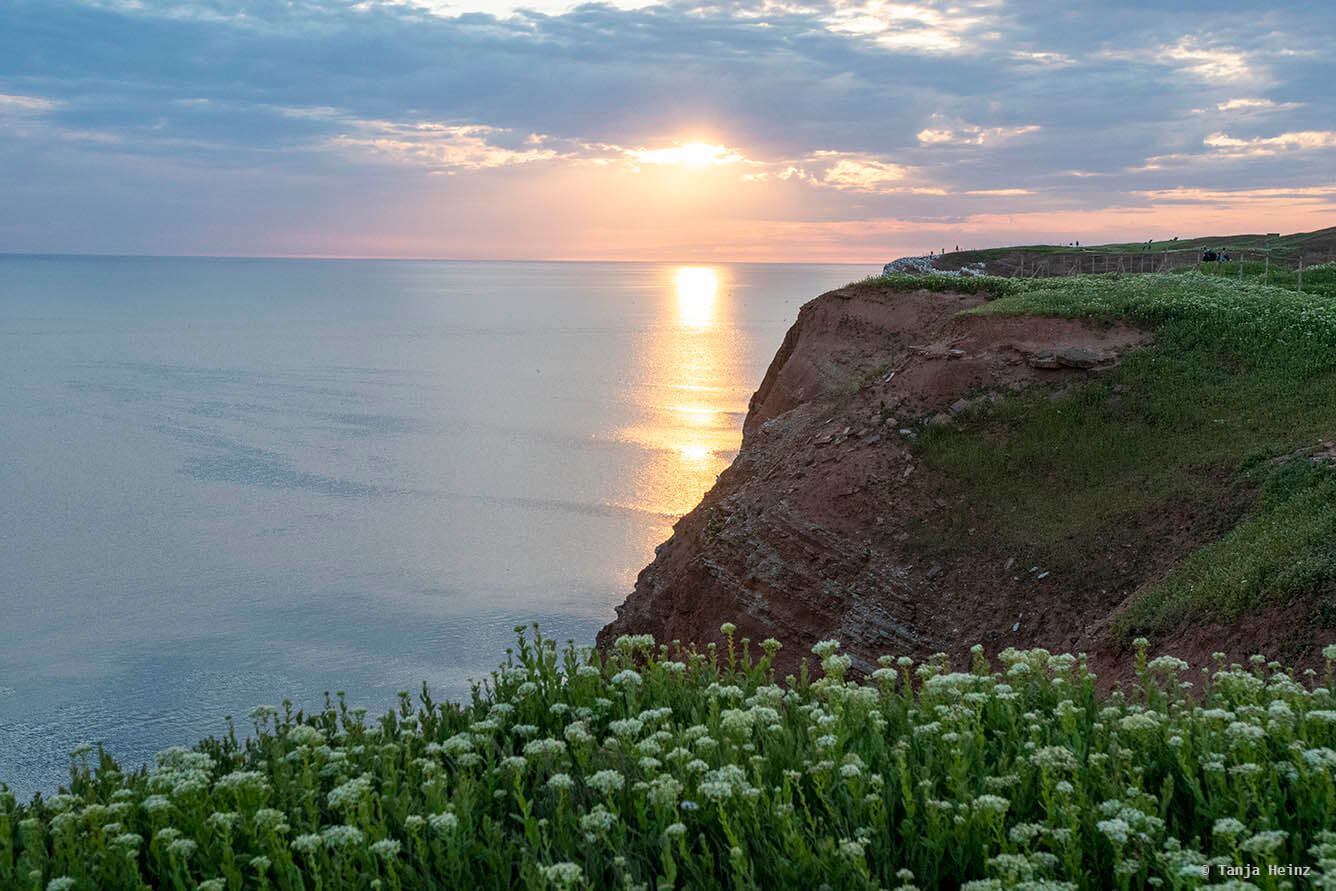
The colors, the sound of the sea, and the flying birds. Magic and just beautiful. Thus, difficult to express in words...
Anyway, in the next paragraph I go more into the northern gannets I observed at the Lummenfelsen.
Northern gannets at the Lummenfelsen
If you are looking for a place with good chances to observe northern gannets (Morus bassanus), Heligoland is definitely one of those places. On the cliffs of Heligoland thousands of sea birds breed every year on the cliffs of the Lummenfelsen and the close-by Tall Anna. Although I haven’t found any reliable or up-to-date numbers, I experienced the cliffs at the northwest of the mainland as being dominated by the northern gannets. My impression might be biased due to the presence of these birds.
When compared to the other sea birds at the cliffs, northern gannets are with a size of almost 100 cm even larger than a herring gull. With their yellowish heads, black-tipped wings, and their long bills, they cannot be confused with any other bird species.
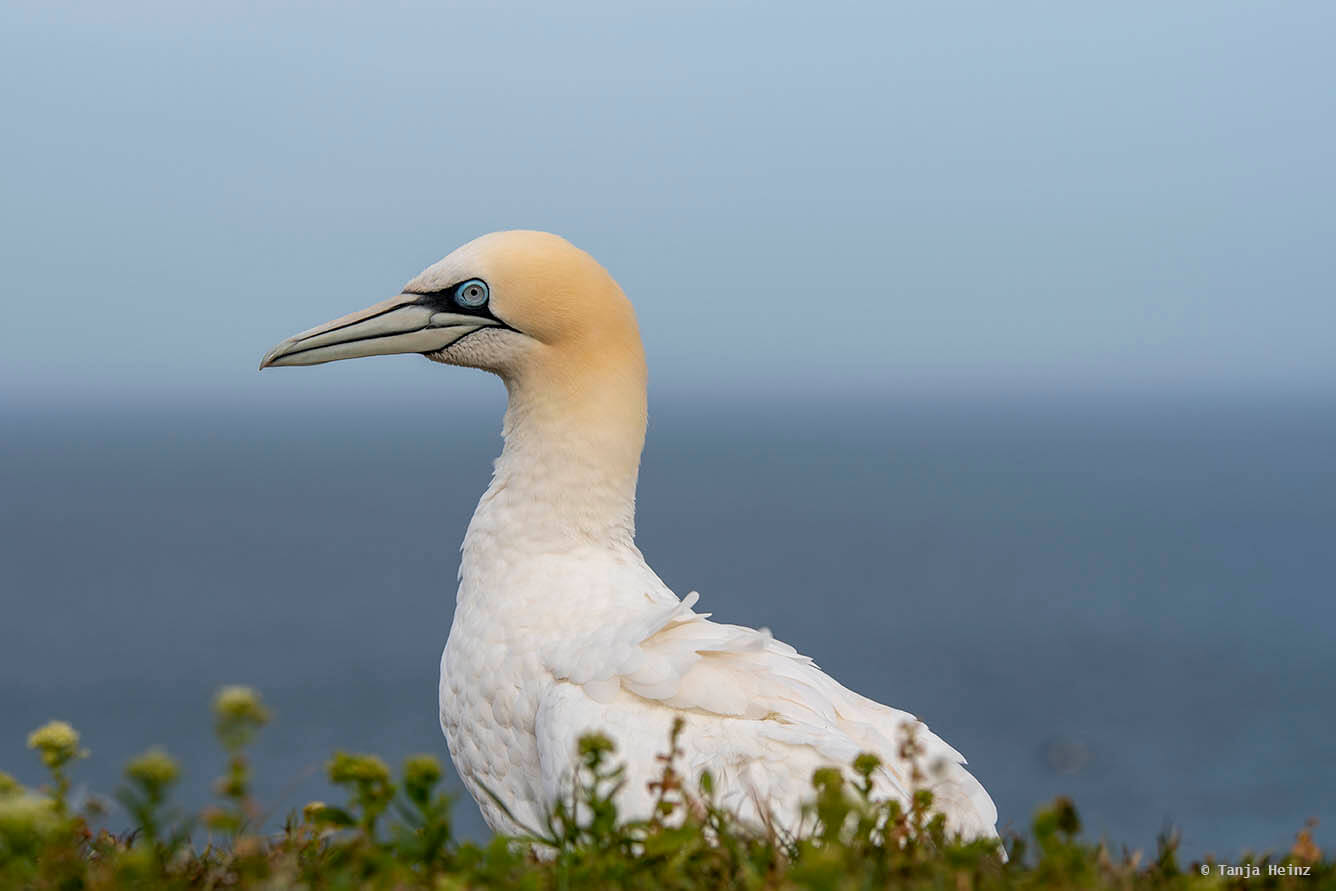
Northern gannets have a long beak curved slightly downward at the end. The beak is colored in a blue-grey tinge.
Their irises are likewise in a light blue to light grey color, and their eyes are surrounded by a blue ring. The bare skin around is black.
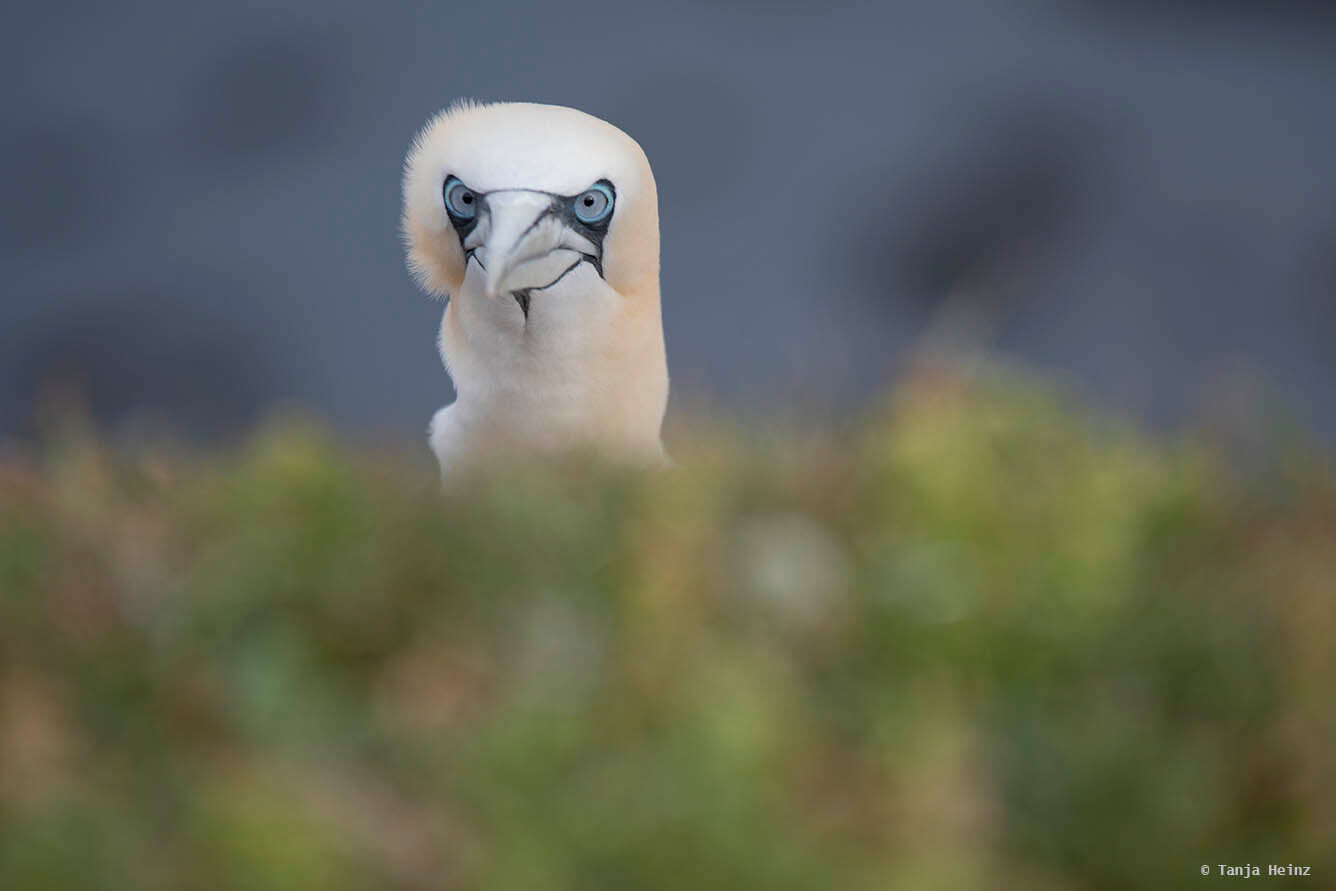
Information: The northern gannet belongs to the genus Morus. There are two more species that belong to this genus: the Cape gannet (Morus capensis) in Southern Africa and the Australasian gannet (Morus serrator) in New Zealand and Australia. Northern gannets are slightly larger than Cape gannets and Australasian gannets. They also have a slightly thicker bill. There are even some slight differences in the coloration of all three species.
A northern gannet has dark four-toed feet. The toes are connected by a membrane. Yellowish or greenish lines run along the toes up to the legs. Apparently, it is possible to distinguish a male and a female by its feet, as the lines running up the legs might be rather bluish in females. I was trying hard to find a difference in the colors of the legs between males and females, but I couldn’t find any. As I had no northern gannet or bird expert near by, I couldn’t ask anyone about this.
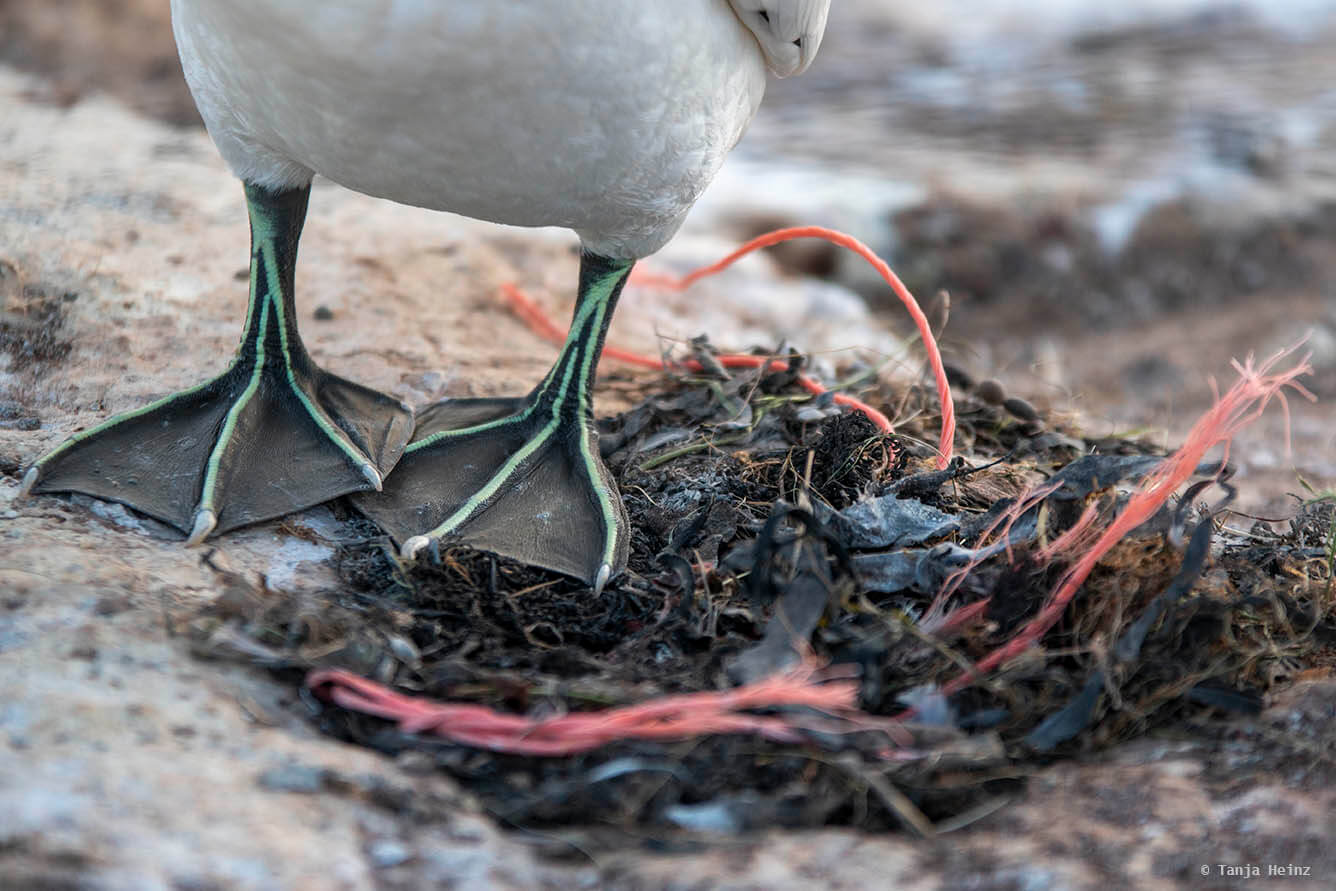
I had not seen any fledgling of northern gannets on my visit, as I was there in May. But fledglings are mostly colored from dark grey to slate grey and speckled with white. Furthermore, their iris is still colored dark brown. In the following seasons juveniles gradually appear more and more like an adult individual with more white in their plumage.
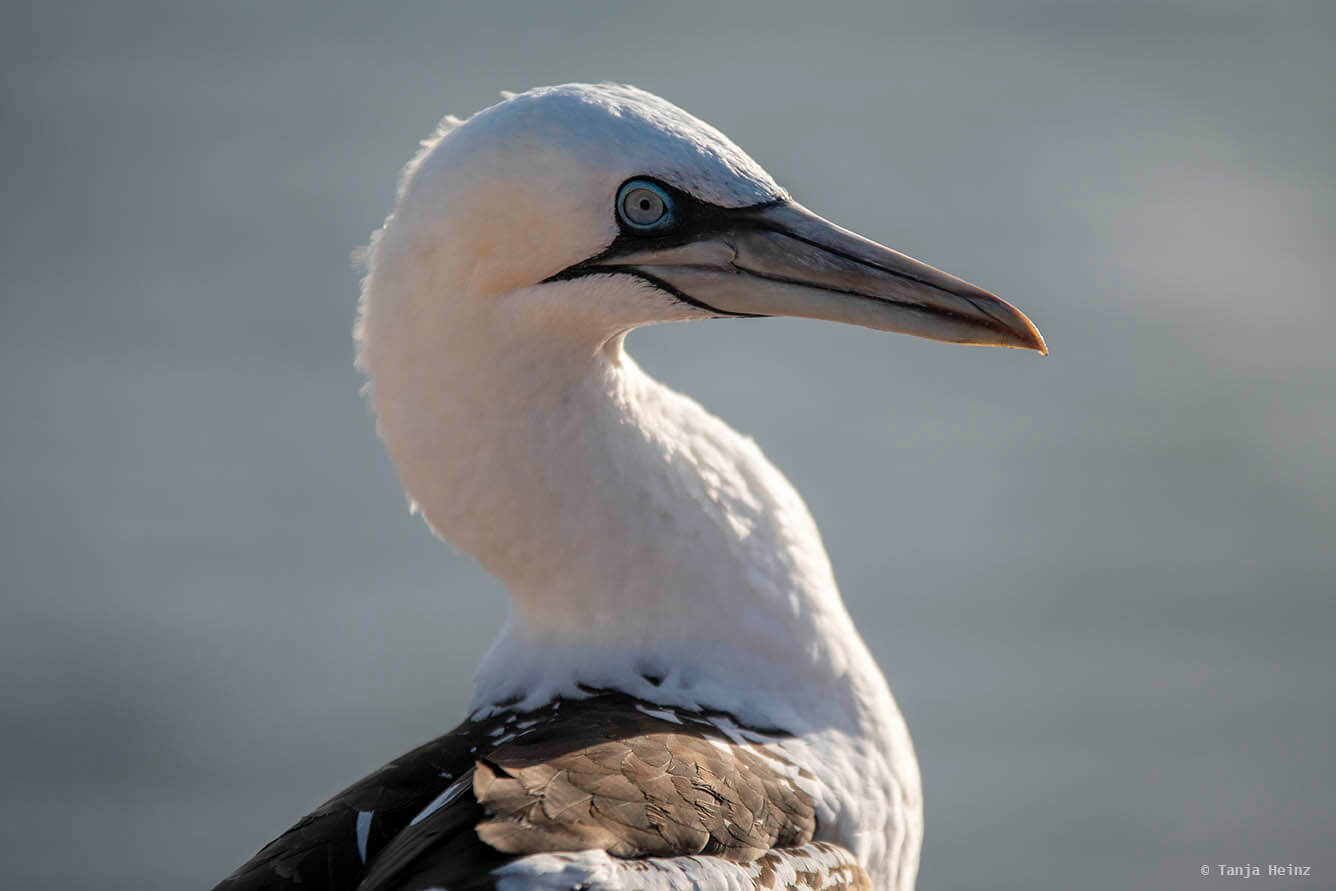
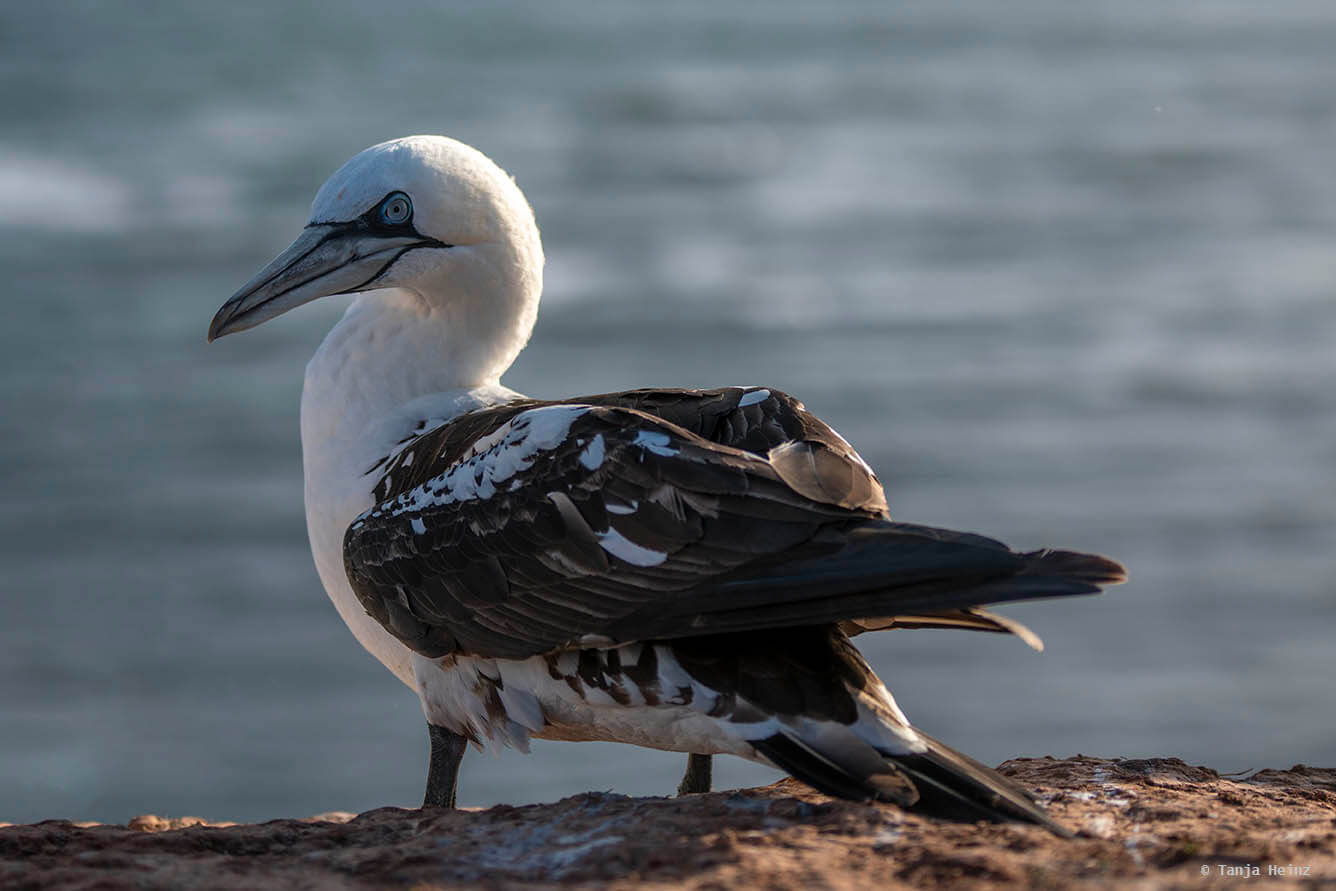
Northern gannets breed on Heligoland since 1991. There is no other place within Germany where northern gannets breed. Since 2003 these sea birds do not only breed on the Lummenfelsen, but also on Tall Anna.
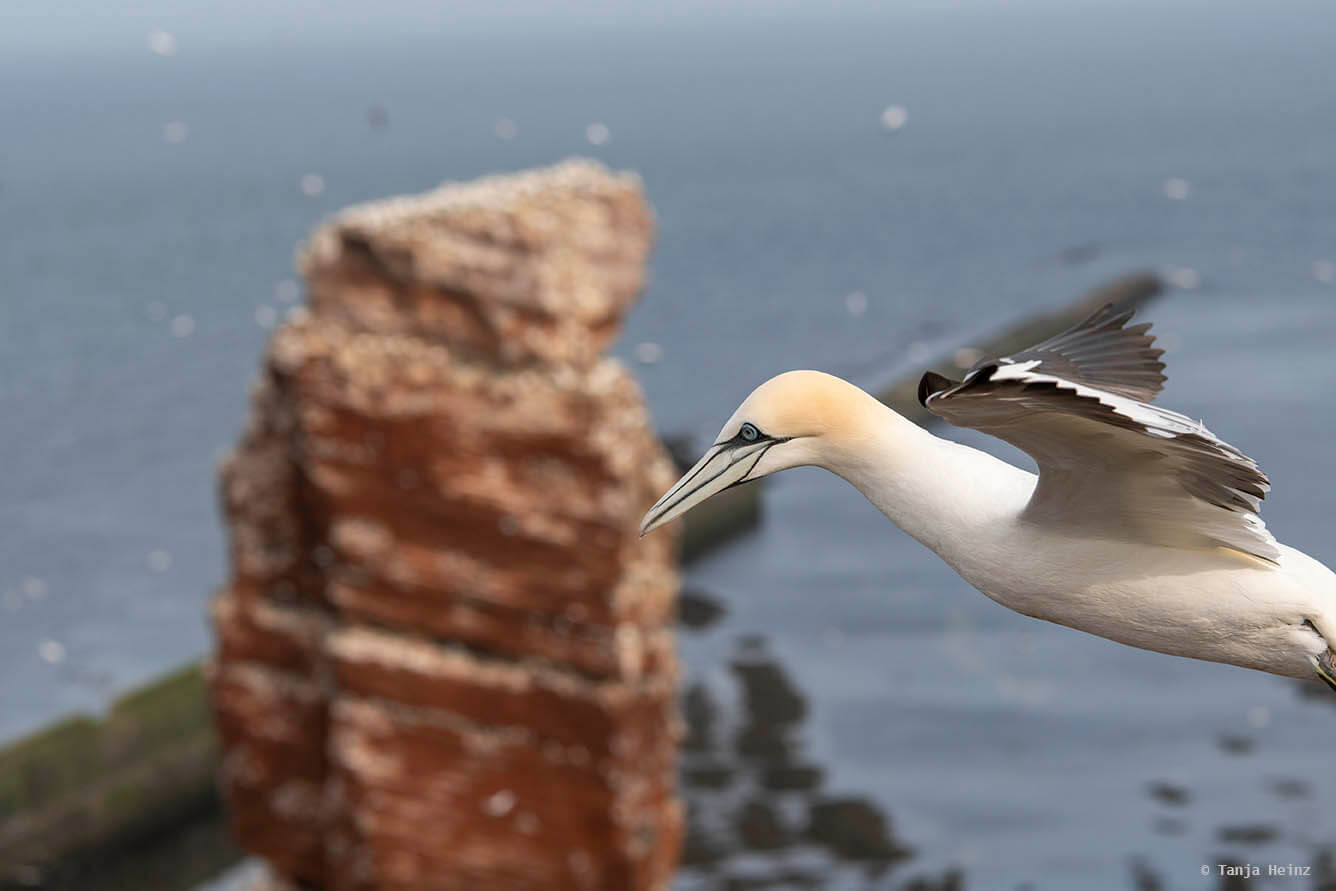
Out of all the five sea birds that only breed on Heligoland within Germany, northern gannets stay the longest in the sea bird colony. They stay from March to October around the cliffs.
Northern gannets lay chalky-blue eggs. Incubation takes between 42 and 45 days. Adults feed their young for about three months. At the age of 84 to 97 days, young northern gannets fledge. Meaning, they launch themselves off a cliff and fly out to the sea.
Usually, northern gannets only lay one egg. Sometimes two eggs might be in a nest. If this is the case, the other egg might have been from another female or the egg was stolen from another nest. If northern gannets loose their egg, they will lay another egg.

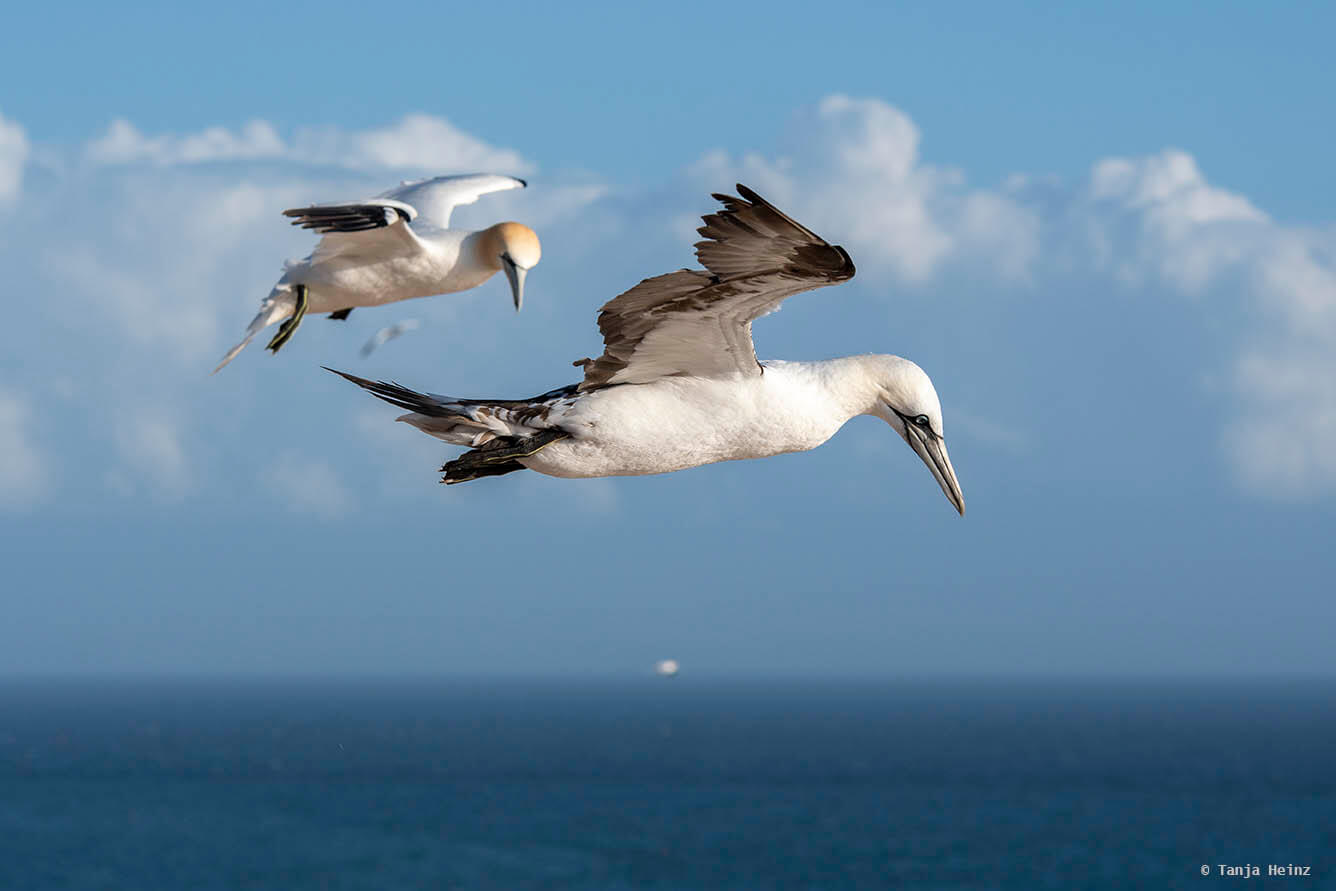
Apropos colony. The northern gannet is a colonial breeder. The bird breeds on islands like on Heligoland, but also on coasts.
On Heligoland they breed quite close to the pathways on the Upper Land of the mainland.
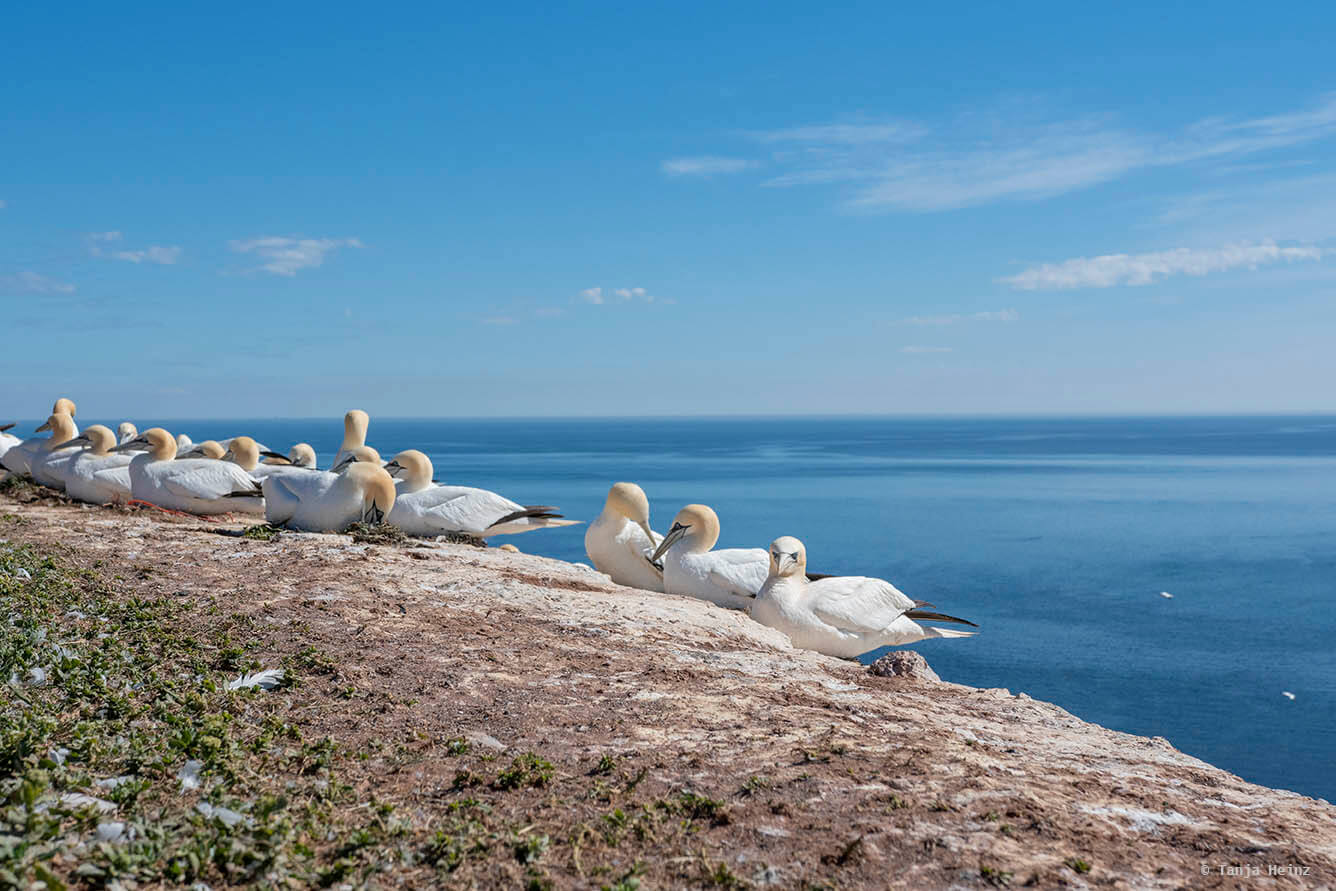
Information: In the United Kingdom there are several sites where northern gannets breed. Especially in Scotland where the world’s largest colony of northern gannets breed at the Bass Rock. More breeding colonies can be found on Alderney, Channel Islands, in Norway and even in Russia, but also in North America.
When I was sitting on the three steps which belonged to the pathway, I was observing quite different behavior between the northern gannets. As it was my first time seeing these birds, I was not sure if I ascribed my behavioral observations to the correct meaning.
I observed quite often northern gannet couples standing breast to breast and their wings spread. Their bills tending upwards. Then they were fencing rapidly with their bills. Sometimes interspersed with calls.
Is this a way to greet each other or is it a way to strengthen a bond?
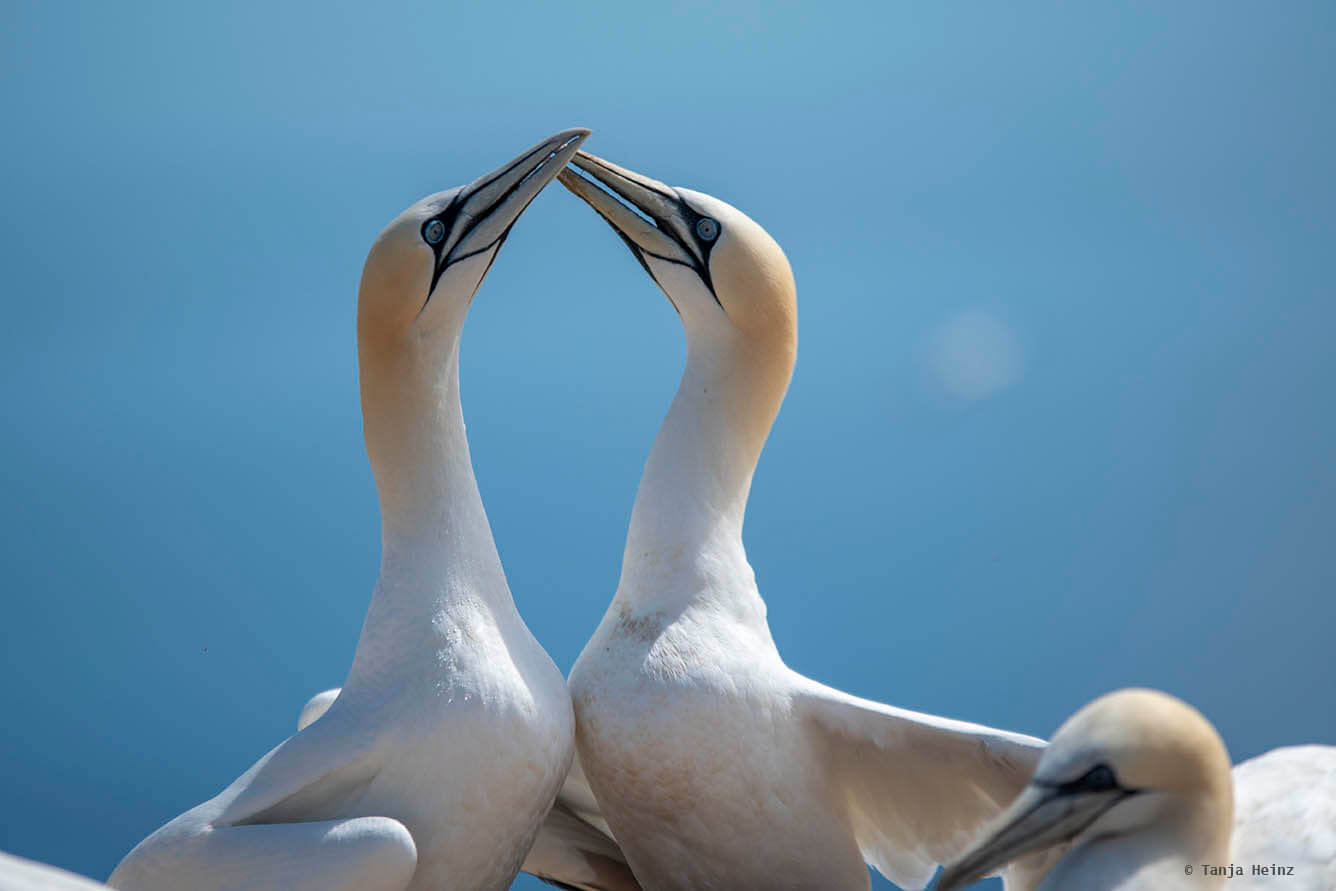
In one moment I even saw a northern gannet couple mate.
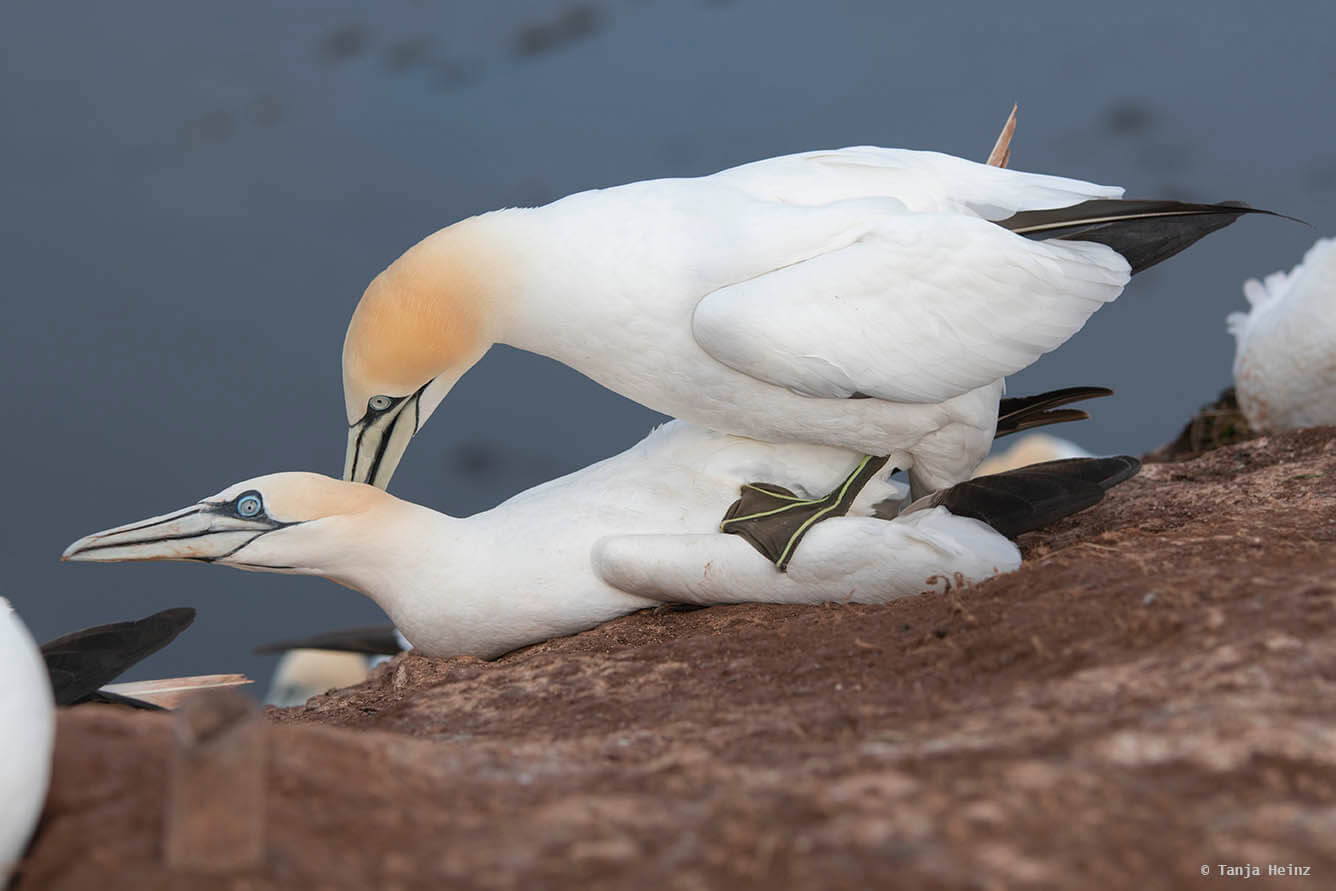
In other moments I saw more aggressive behavior between the northern gannets. Apparently, northern gannets show aggressive behavior especially between individuals of the same sex.
I saw a northern gannet how it was lowering its head before an obviously aggressive individual which took the exposed back of the other individual in its beak. Is this a way to expel a northern gannet from a nest?
The individual on the following photograph (probably a juvenile) left the site after this interaction.

Apparently and as far as I know, typically, females would not react to a male that approaches, but to other females.
I quite frequently observed northern gannets lunge at each other with their bills.
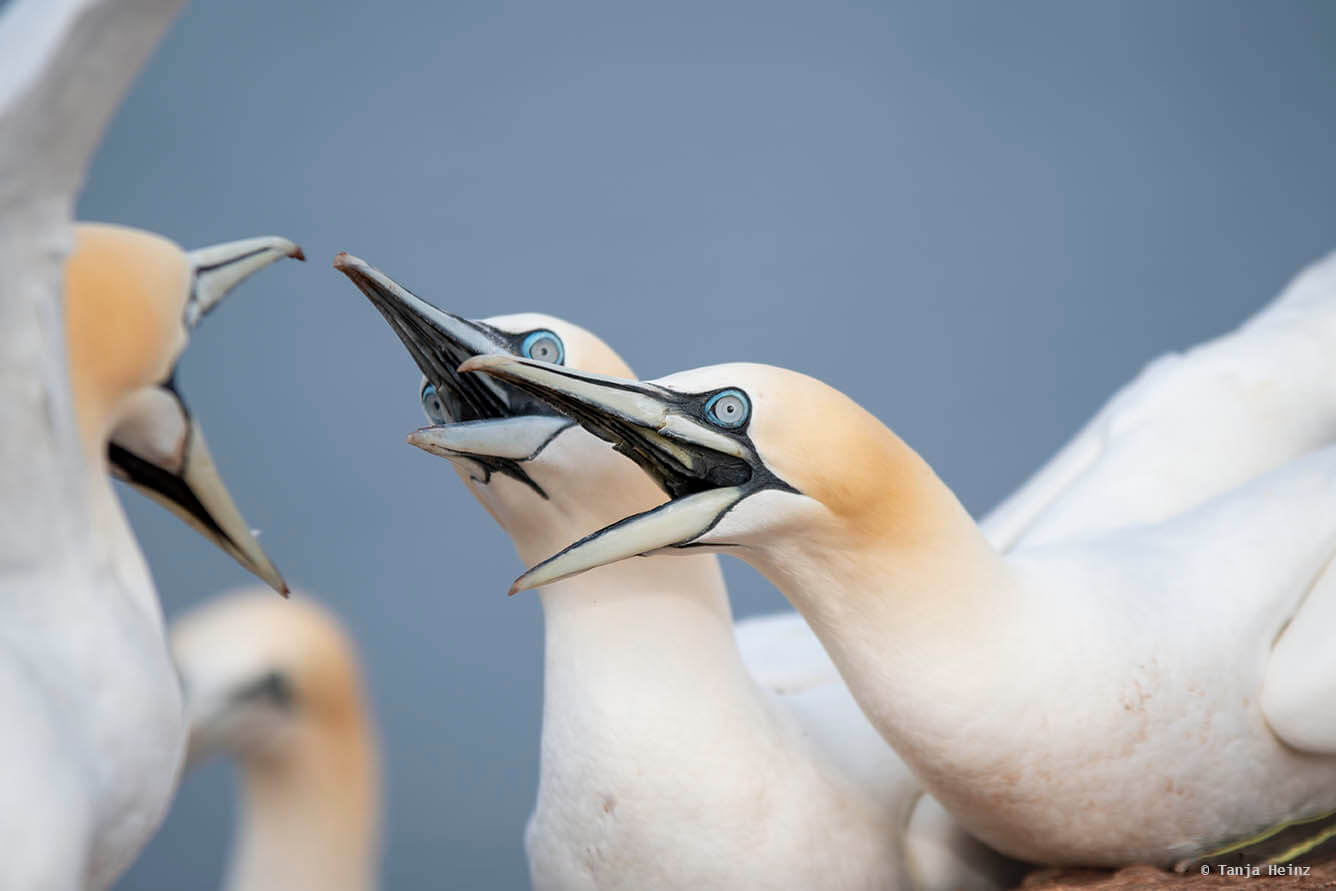
Sometimes I saw northern gannets pecking at other birds.
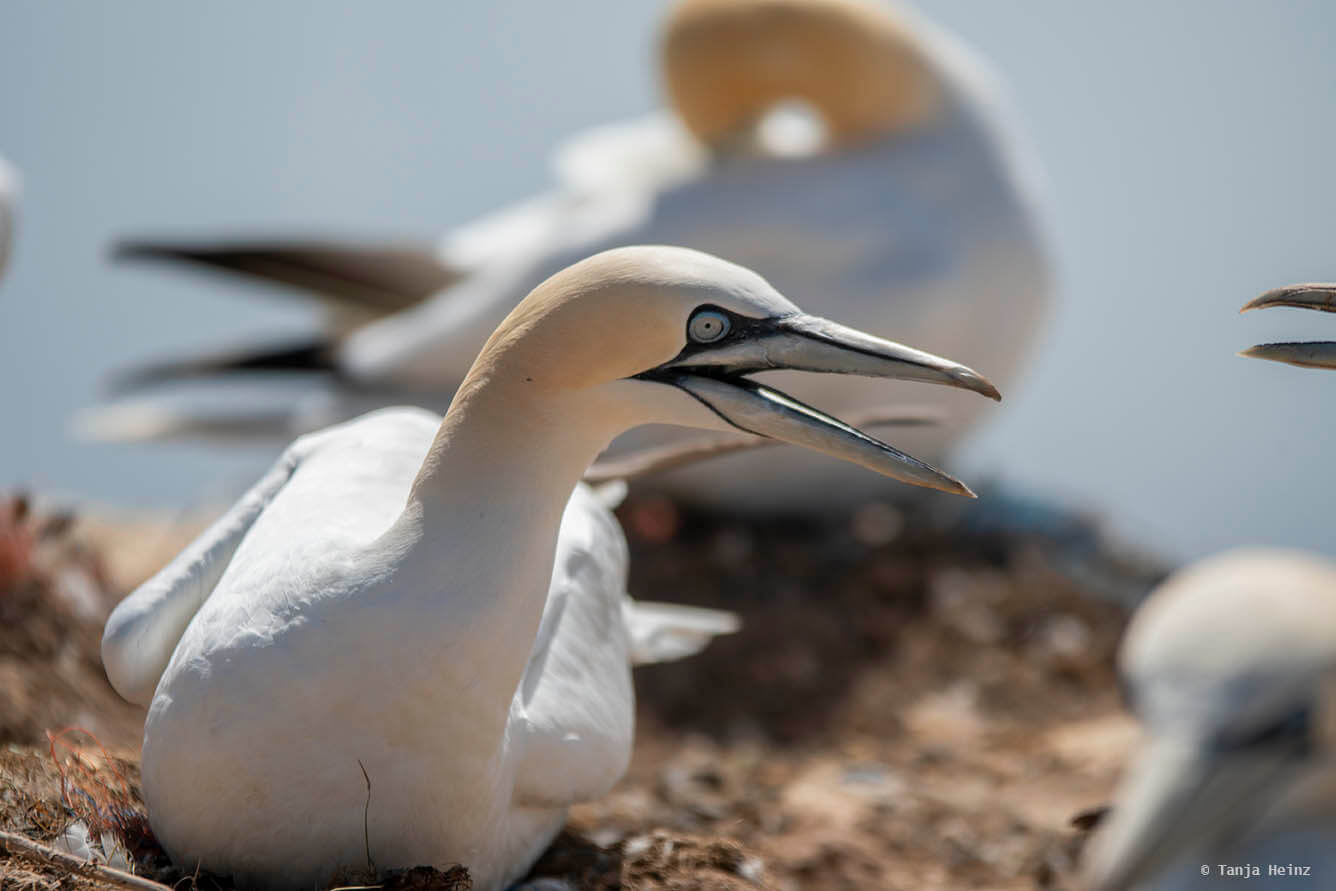
Did you know? The lifespan of a northern gannet is typically 17 years. However, the maximum documented age of one individual reached 37 years.
I found it quite fascinating sitting there and observing these special birds. When I was sitting there, I was observing all the other people around. In some moments it was quite crowded. In one moment I was even "attacked" by another woman to leave or wear a mask when I positioned myself next to her (it was still a distance of about one meter).
I decided to leave.
Although we were in the middle of a pandemic, sometimes there was no space left to fit in.
One photographer by one photographer. Especially in the evenings.
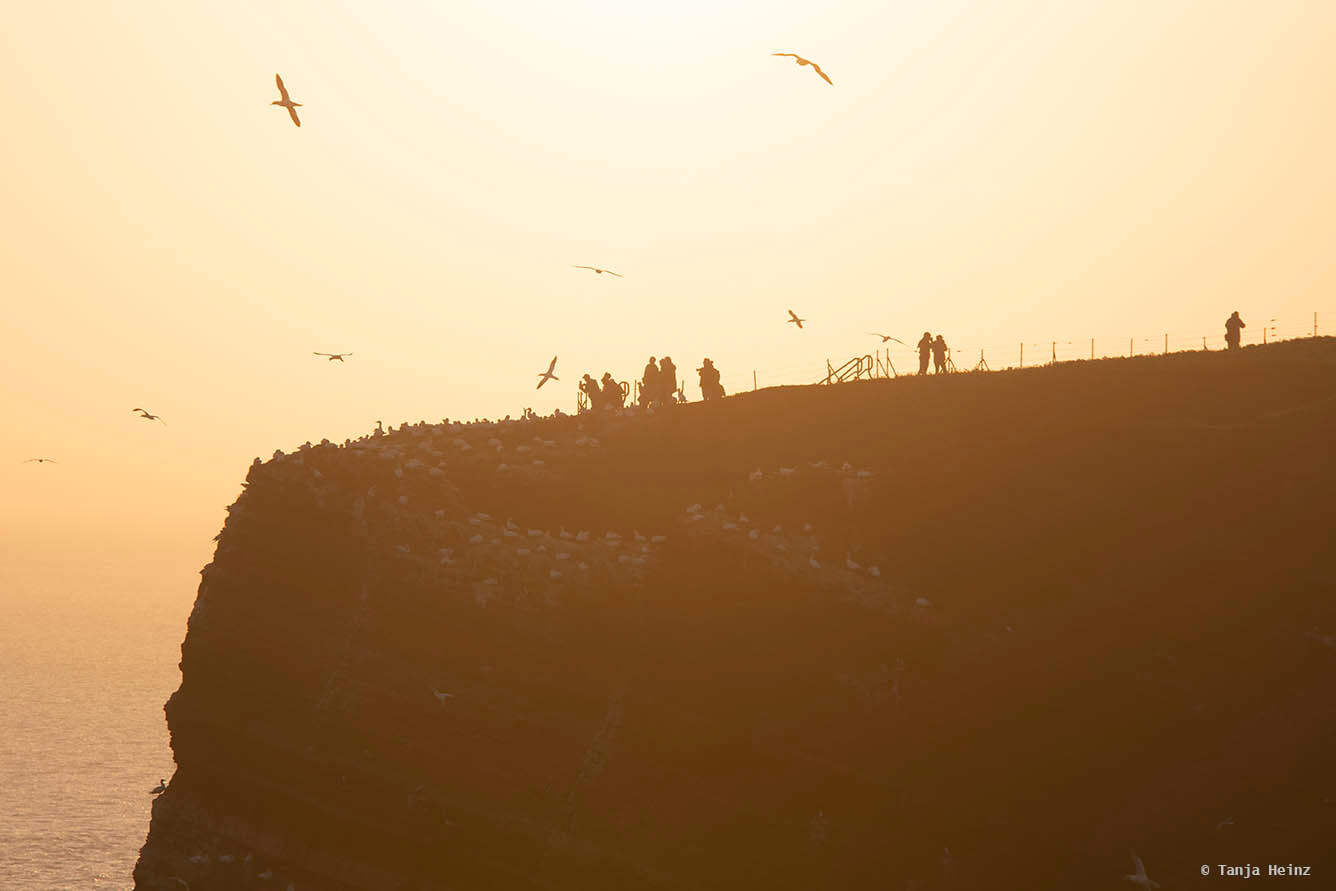
Nevertheless, on my last day it was quite windy and it was a pleasure for me to photograph these wonderful birds in flight.
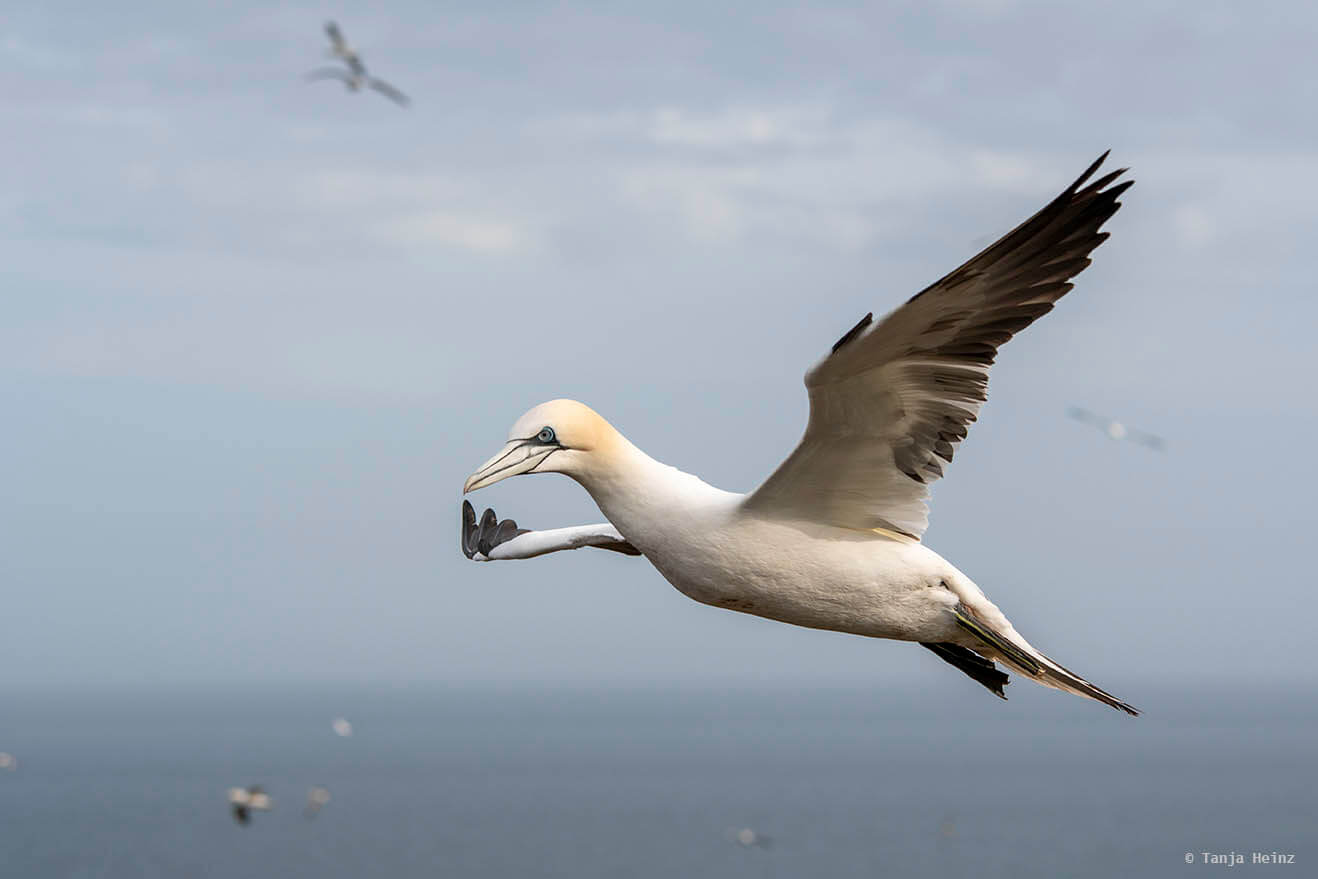
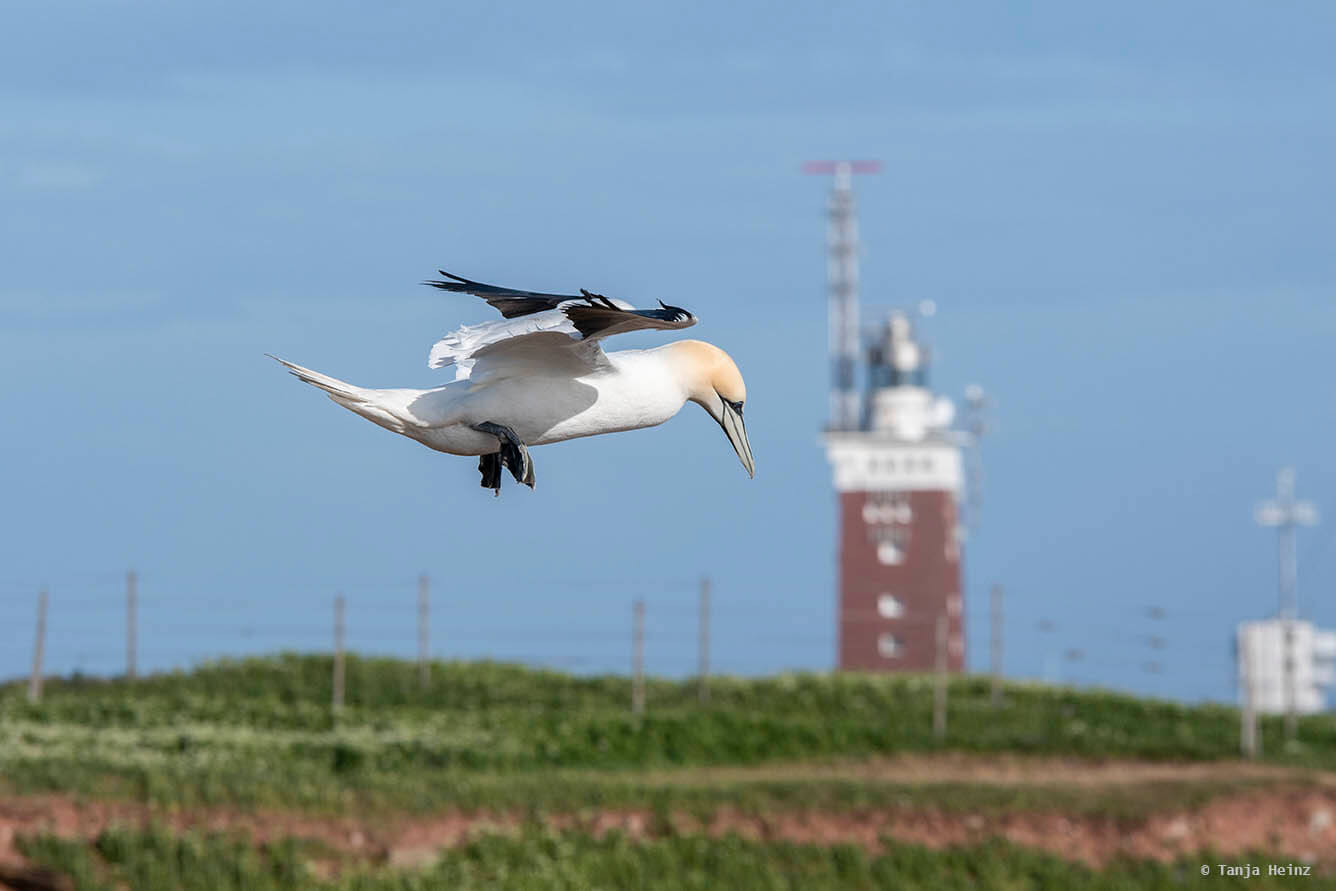
As their nests typically are made from seaweed, other plants or debris from the sea, I saw them bringing material like seaweed to their nests.

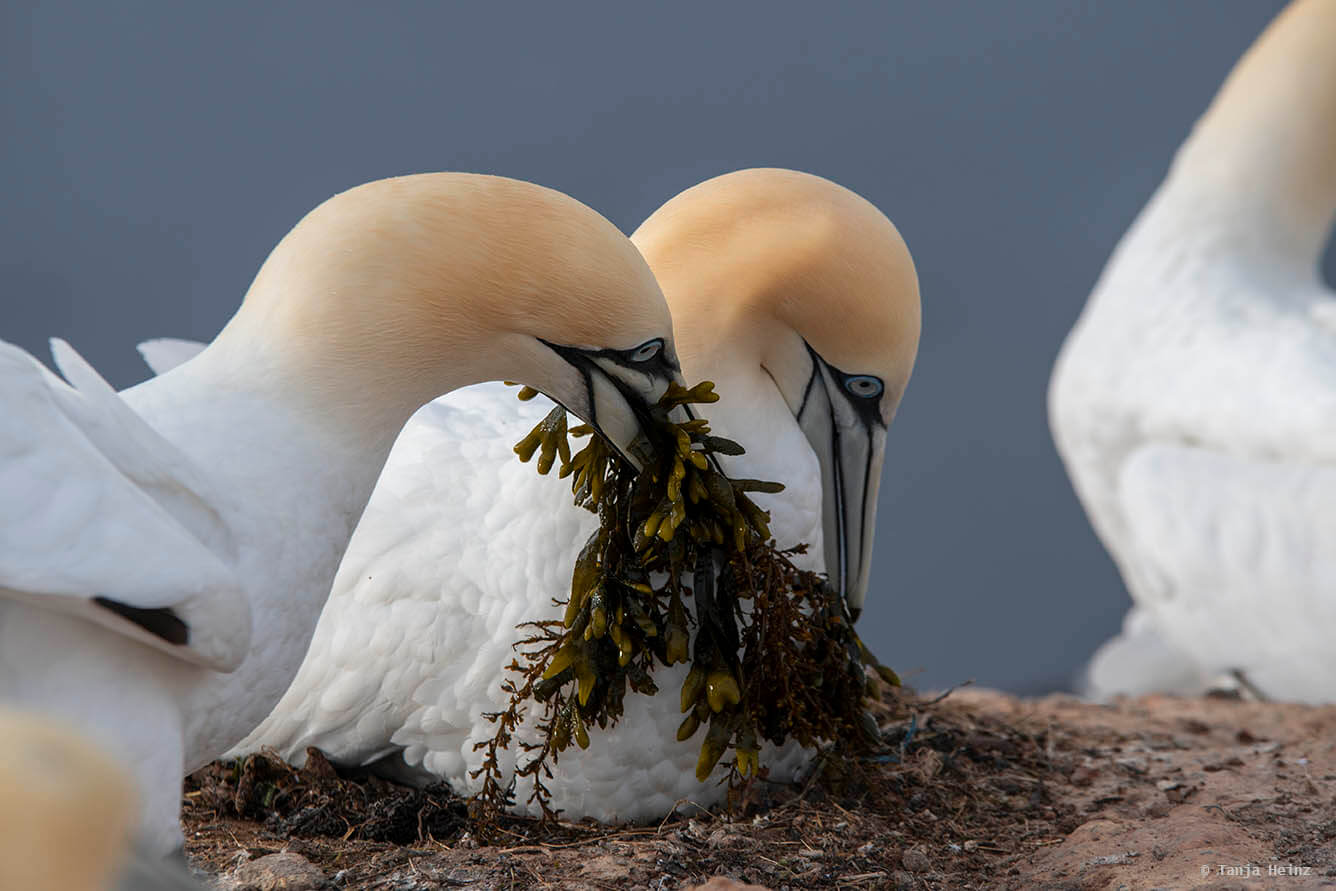
Unfortunately, northern gannets also transport actively artificial material to their nests like plastics.
This is one of the reasons why Jordsand - a local association dedicated to the protection of nature on Heligoland - initiated a project about the impacts of plastics on sea birds. They want to find out where this plastics come from. New knowledge about the impacts of plastics on sea birds and its origin might help to develop recommendations for action in order to reduce plastics in the North Sea, and finally, promote the conservation of sea birds like northern gannets.
When I was observing the northern gannets, I saw quite many of them with plastic material in their nests.
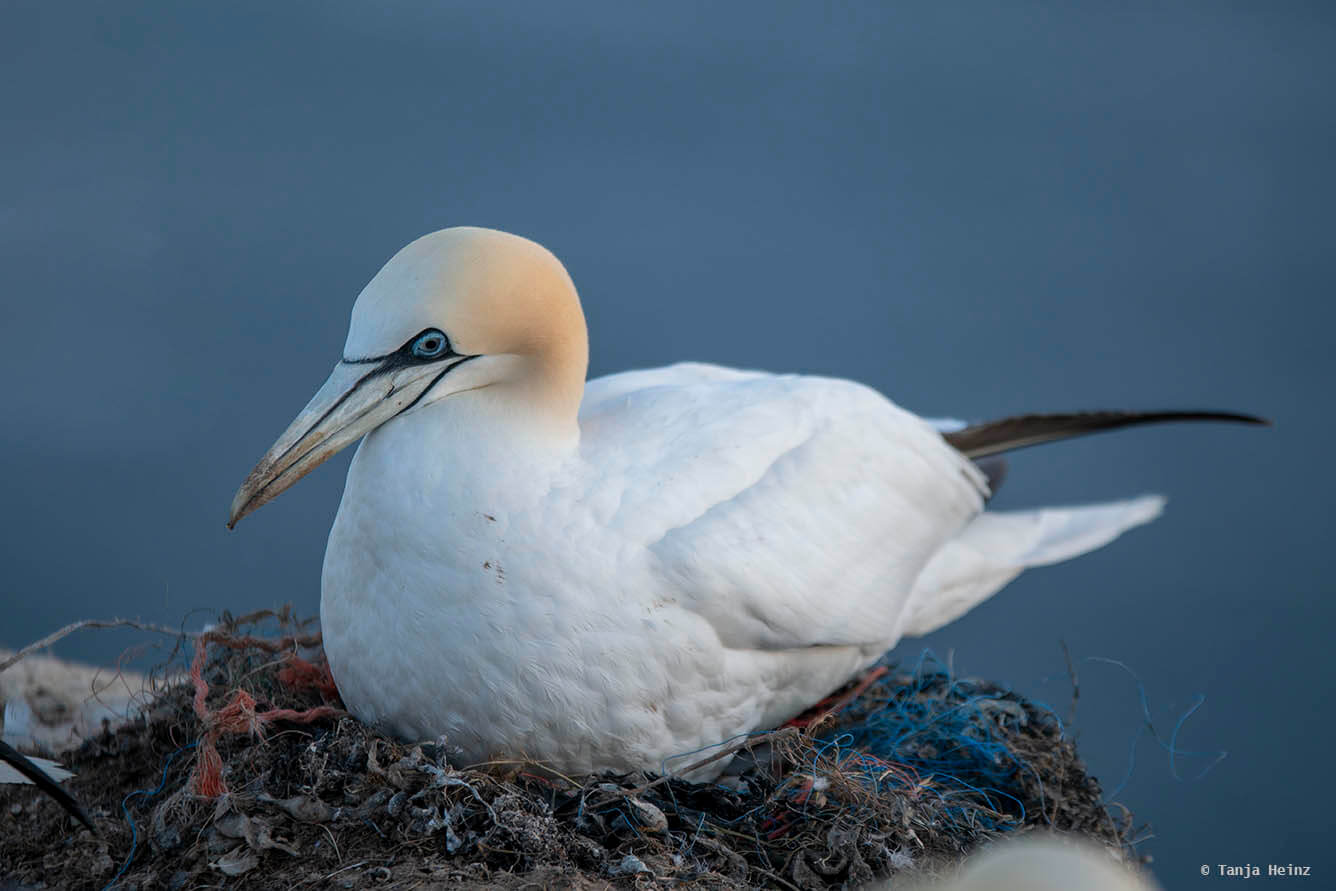
Information: If you want to know more about plastics and northern gannets, please check the website of the association Jordsand.
Unfortunately, the association Jordsand was closed during the time of my visit due to the Coronavirus pandemic. But as far as I could find out, they regularly check the cliffs of Heligoland where the northern gannets and all the other sea birds breed. As sea birds regularly entangle in artificial nest materials, they want to find out, for example, which sea bird species and how many die because of such plastic materials. Often they become entangled, but they are not able to disentangle themselves. How old are these sea birds entangled in plastics on the cliffs and which kind of material is most responsible for the death of them are two important questions.
On my visit I became a witness of this issue. I saw two northern gannets and a common guillemot entangled in a net.
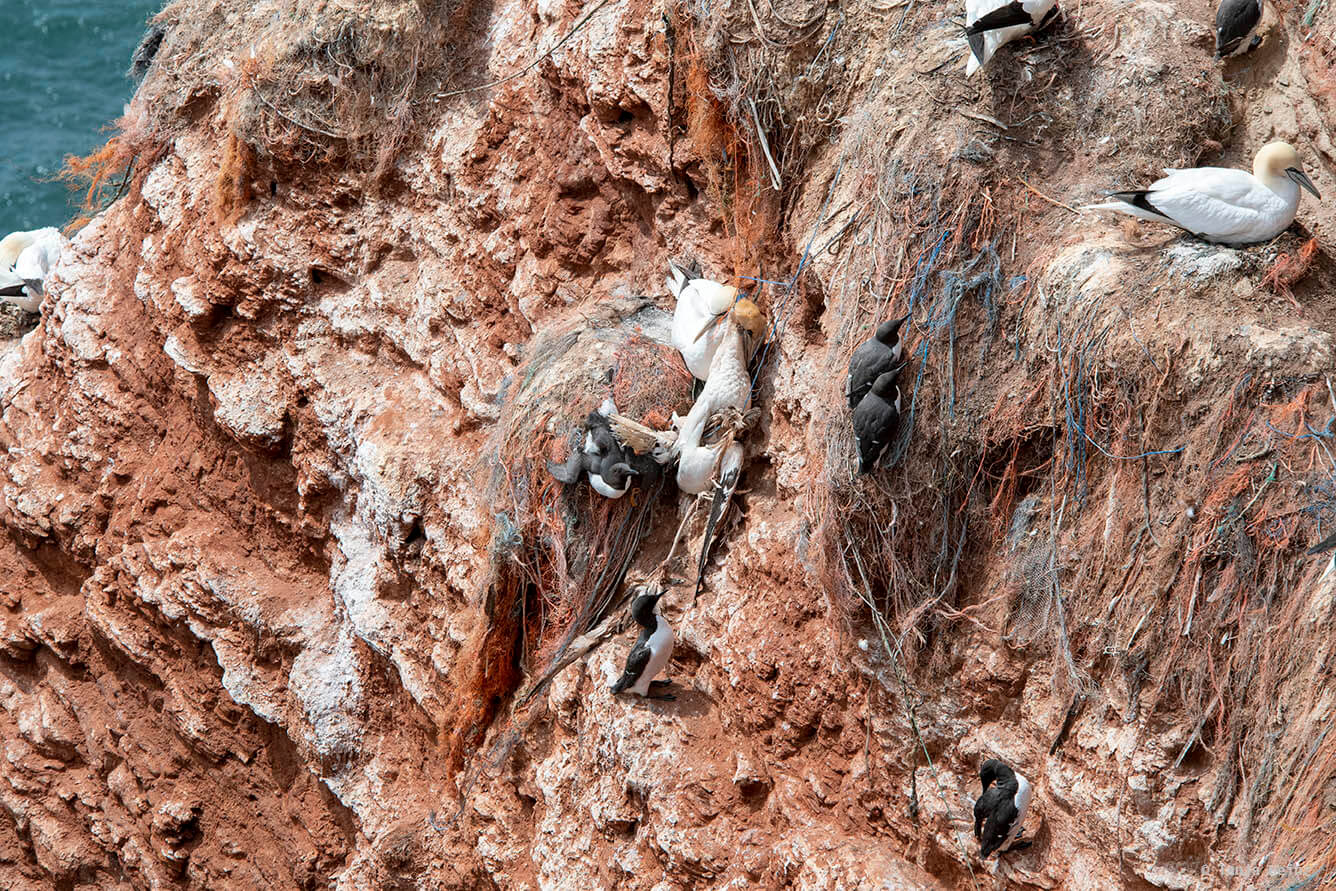
According to the website of Jordsand, it is not possible to remove the plastics from the nests of the northern gannets. Neither is it possible to rescue individual sea birds due to the red sandstone of the cliffs. The only action that can be done is to reduce plastic pollution.
One of the two northern gannets was already dead. They other northern gannet was apparently still able to move its head. The common guillemot, in contrast, was entangled with one of its legs. It was so heartbreaking to see them hanging there. Knowing that their life is slowly coming to an end at these cliffs...
I felt not good to photograph these birds in their unfortunate situation. But I had to. Photography for me is not just taking nice and beautiful photographs. There are environmental problems out there that need to be addressed. Environmental problems that need more awareness in the public. And I think all this can be better reached with photographs hard to take.
Information: According to the IUCN the northern gannet is classified as "Least Concern" and their populations are even increasing. However, their behavior of bringing actively plastics to their nests should be an indicator of how polluted our oceans are with plastics. And every individual death of a northern gannet caused by us humans is tragic. Thus, their relaxed conservation status should not result in making plastic pollution appear harmless.
More birds on Heligoland
There are four more sea bird species that only breed on Heligoland within Germany. These birds are black-legged kittiwakes (Rissa tridactyla), common guillemots (Uria aalge), northern fulmars (Fulmarus glacialis), and razorbills (Alca torda).
Black-legged kittiwakes and common guillemots are quite common around the Lummenfelsen and Tall Anna.
The black-legged kittiwake is a sea bird of the gull family Laridae. According to the IUCN this bird is listed in the category "Vulnerable" and its populations are in decline. Black-legged kittiwakes typically inhabit arctic and subarctic regions of the Atlantic and Pacific.
On Heligoland they can be found from March to August on the cliffs. They preferably build their nests on ledges.


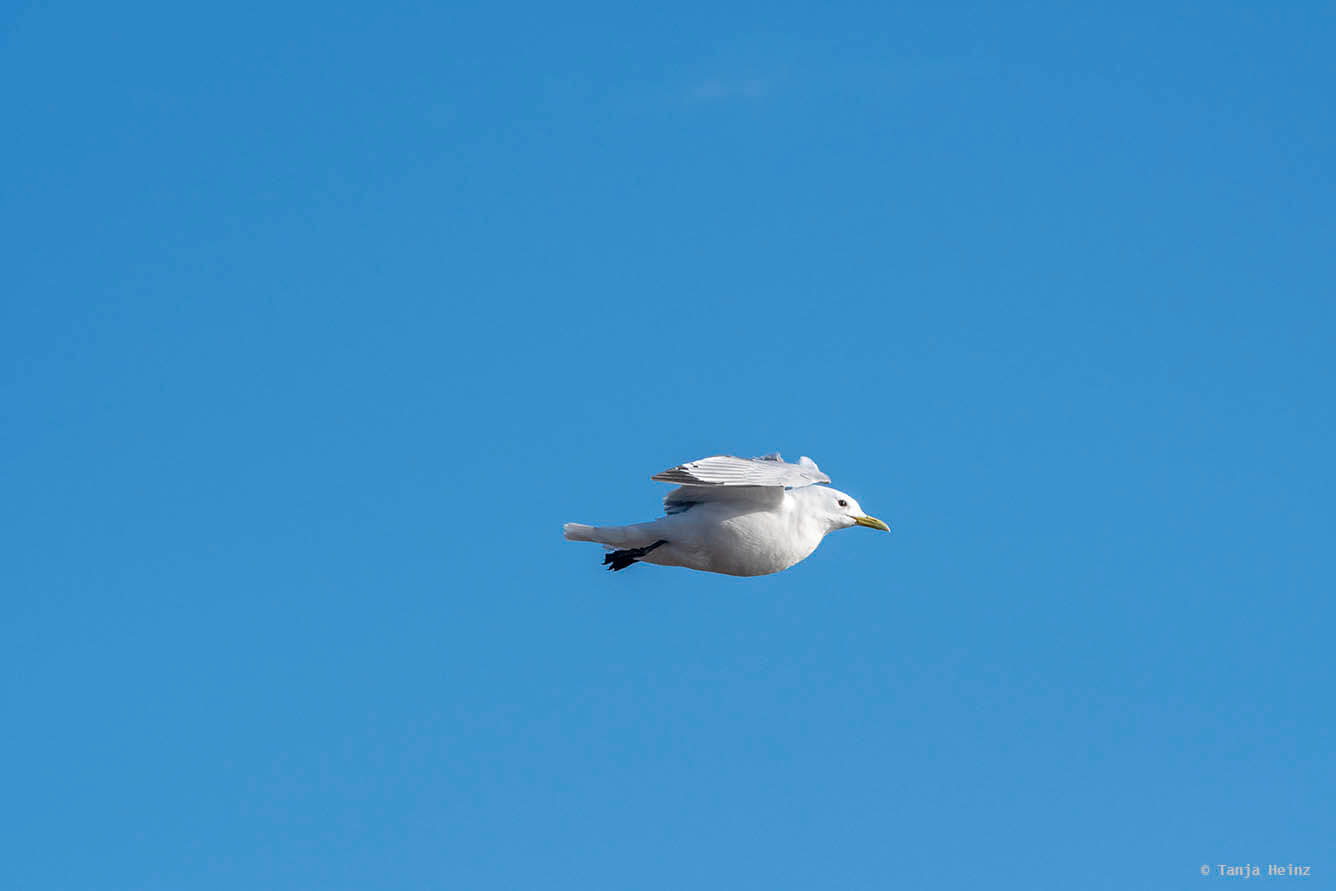
Both black-legged kittiwakes and common guillemots are besides northern gannets very common on Heligoland.
Common guillemots are also known under the name common murre. They are from the auk family Alcidae. I saw another bird of the auk family - a black guillemot (Cepphus grylle) - already in winter on Heligoland. Common guillemots are in the category "Least concern" and their populations seem to increase. Like black-legged kittiwakes, common guillemots prefer the North Atlantic and North Pacific. They spend most of the time at sea. They only come to land for breeding where they will lay an egg on bare rocks.
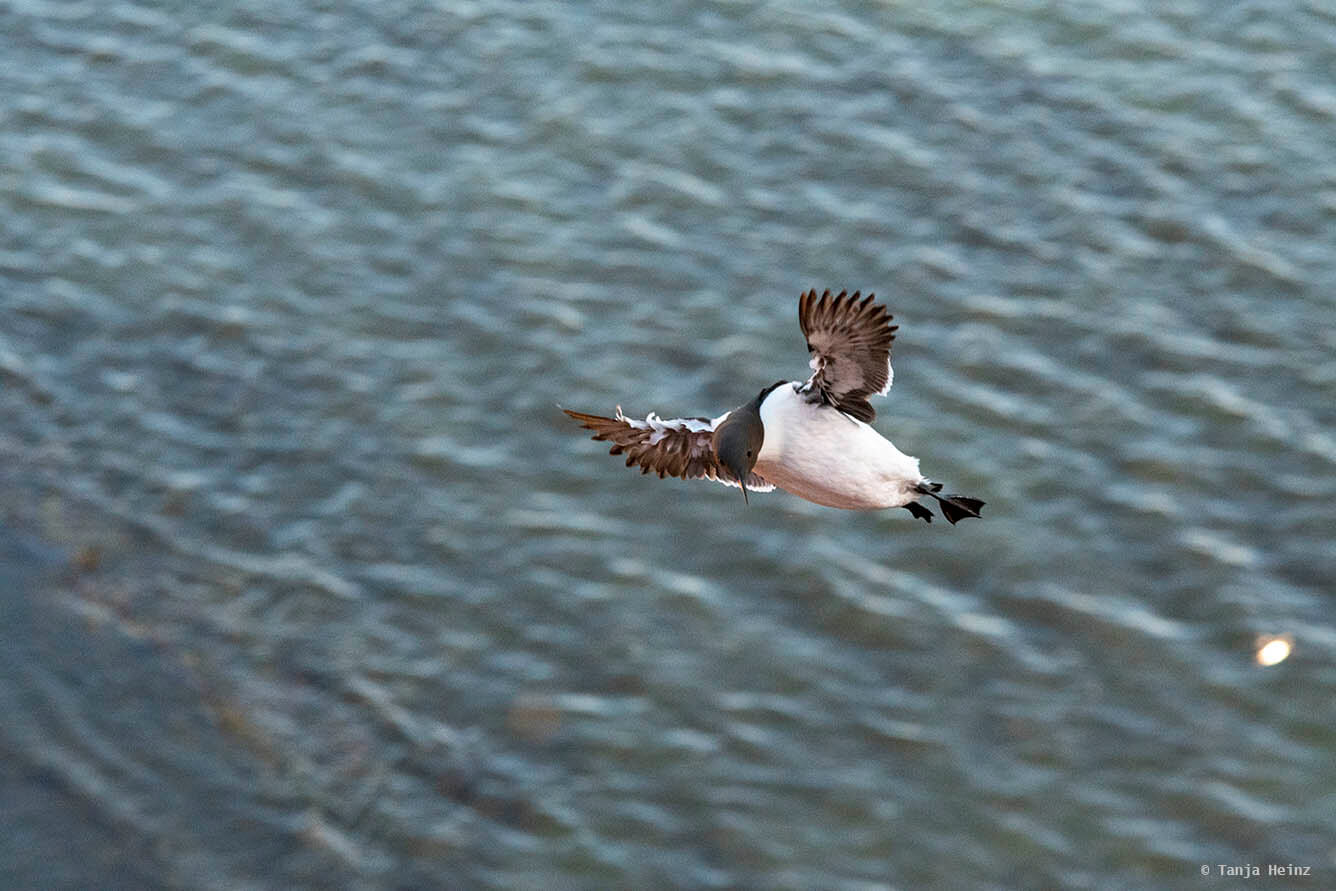
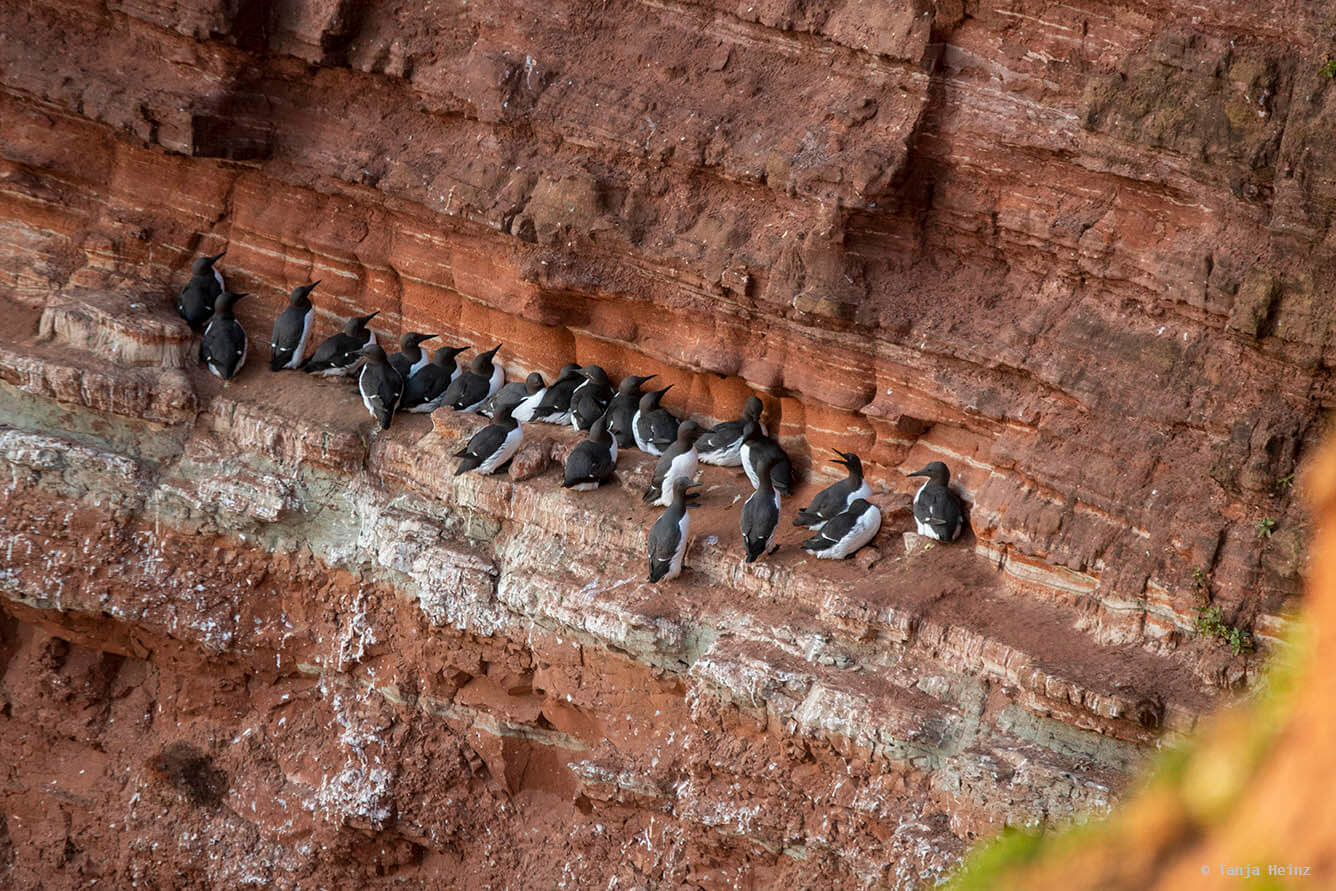
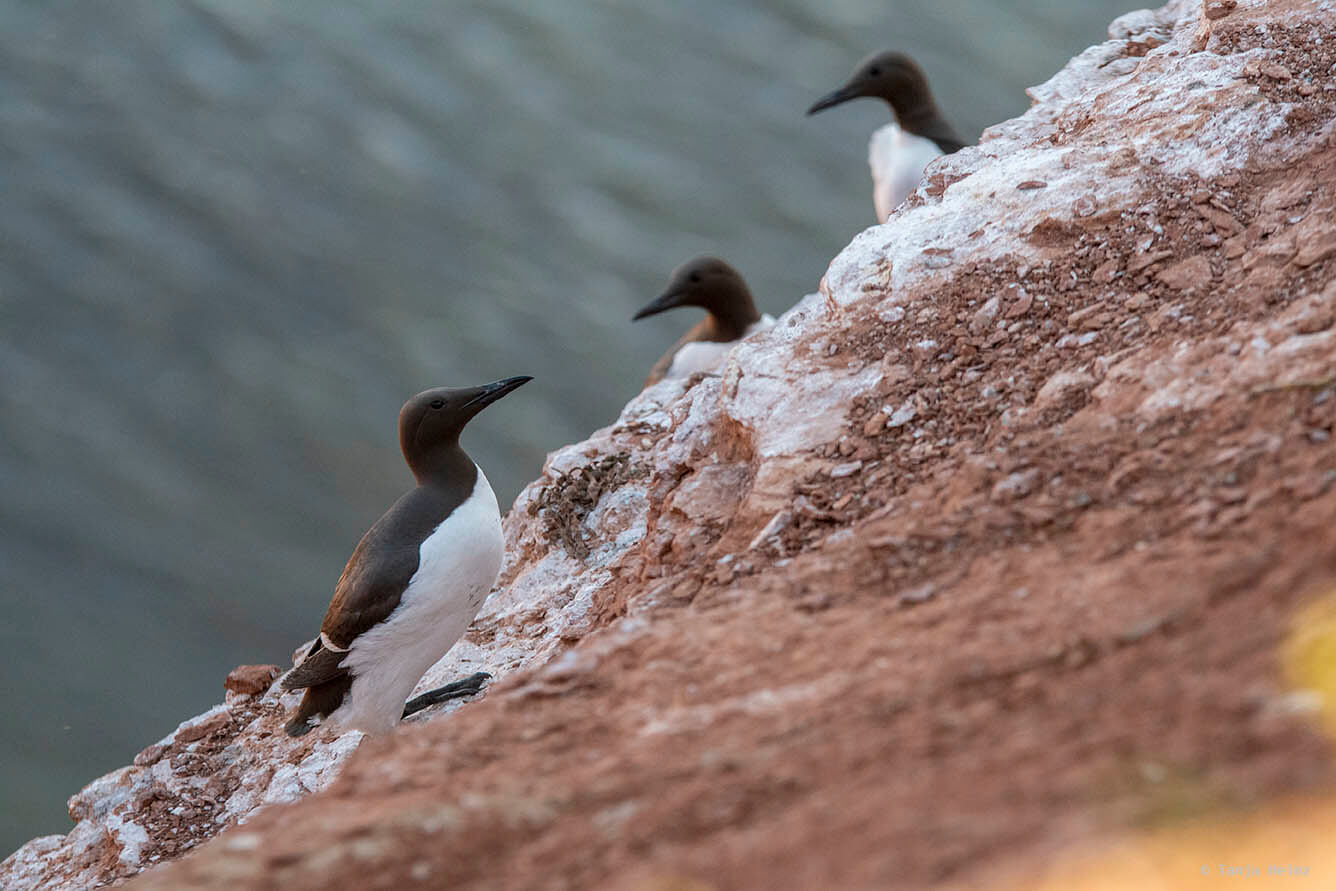
Common guillemots breed from March to July on Heligoland. But sometimes they can be seen on the Lummenfelsen in winter.
Information: Heligoland is known for one specific natural spectacle: chicks gliding from the high cliffs down to the water (German: "Lummensprung"). On Heligoland this natural spectacle can be observed around mid June. Meaning, in July numbers of common guillemots decrease on the cliffs of the Lummenfelsen and Tall Anna.
Northern gannets, common guillemots and black-legged kittiwakes are quite common on the cliffs of Heligoland. Northern fulmars and razorbills, in contrast, are rather rare. Only if you take your time to search the cliffs for these two birds, you will find them.
I spotted a northern fulmar during my stay only once.
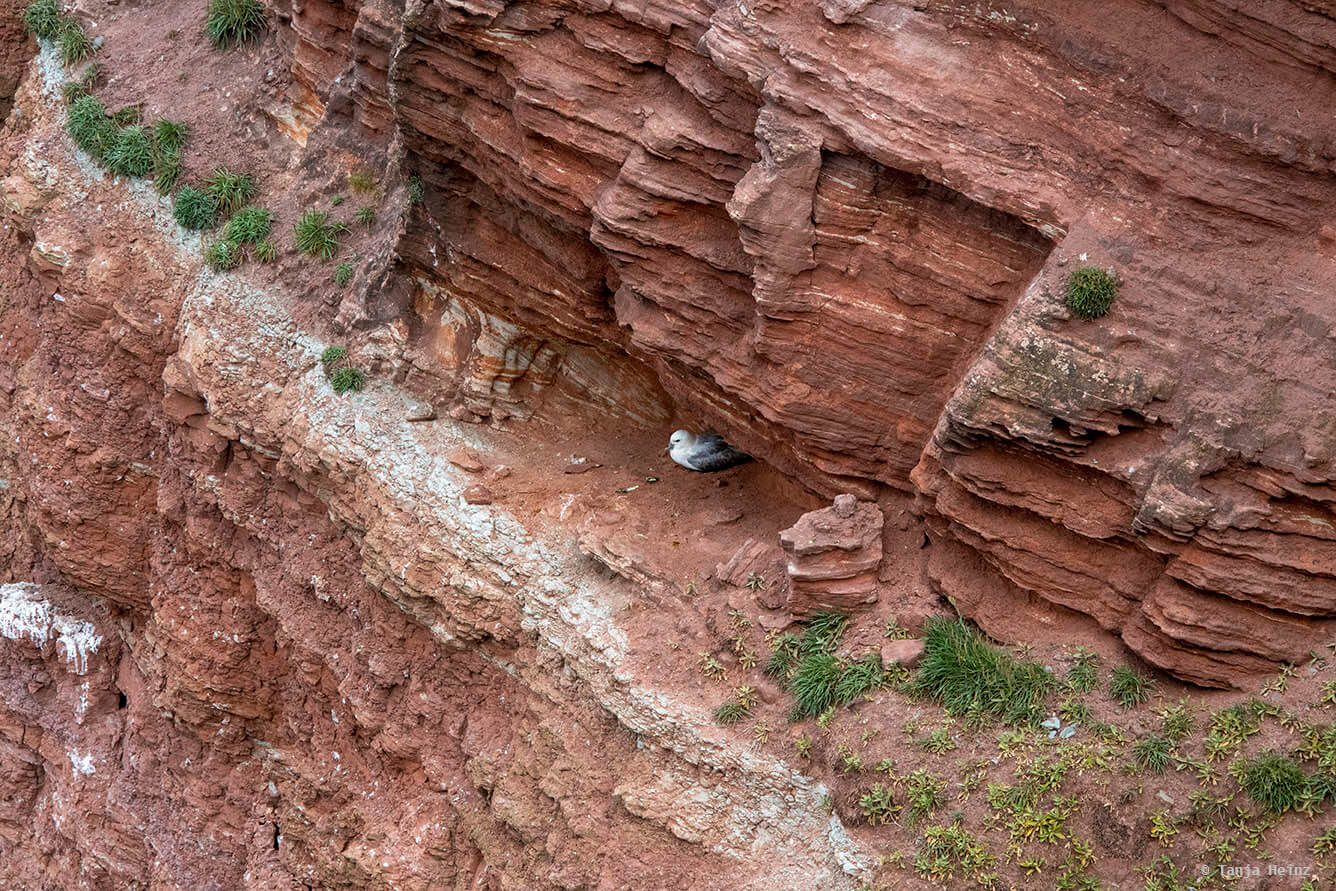
Northern fulmars can be found on Heligoland from March to August. Like common guillemots, northern fulmars might visit Heligoland in winter. They do not build a nest, but lay their eggs on bare rocks. These sea birds are from the family Procellariidae comprising petrels, prions, and shearwaters. Northern fulmars are of "Least Concern" according to the IUCN and there populations still seem to increase. They typically live in waters of the North Atlantic and North Pacific.
As I was keen on spotting all the five species that only breed in Germany on Heligoland, I was scanning the cliffs on all of my visits for razorbills. Like northern fulmars, it was not that easy to spot razorbills among all those common guillemots. But at the end, I spotted razorbills twice. In one occasion I even saw two of them - probably a couple - at one spot.
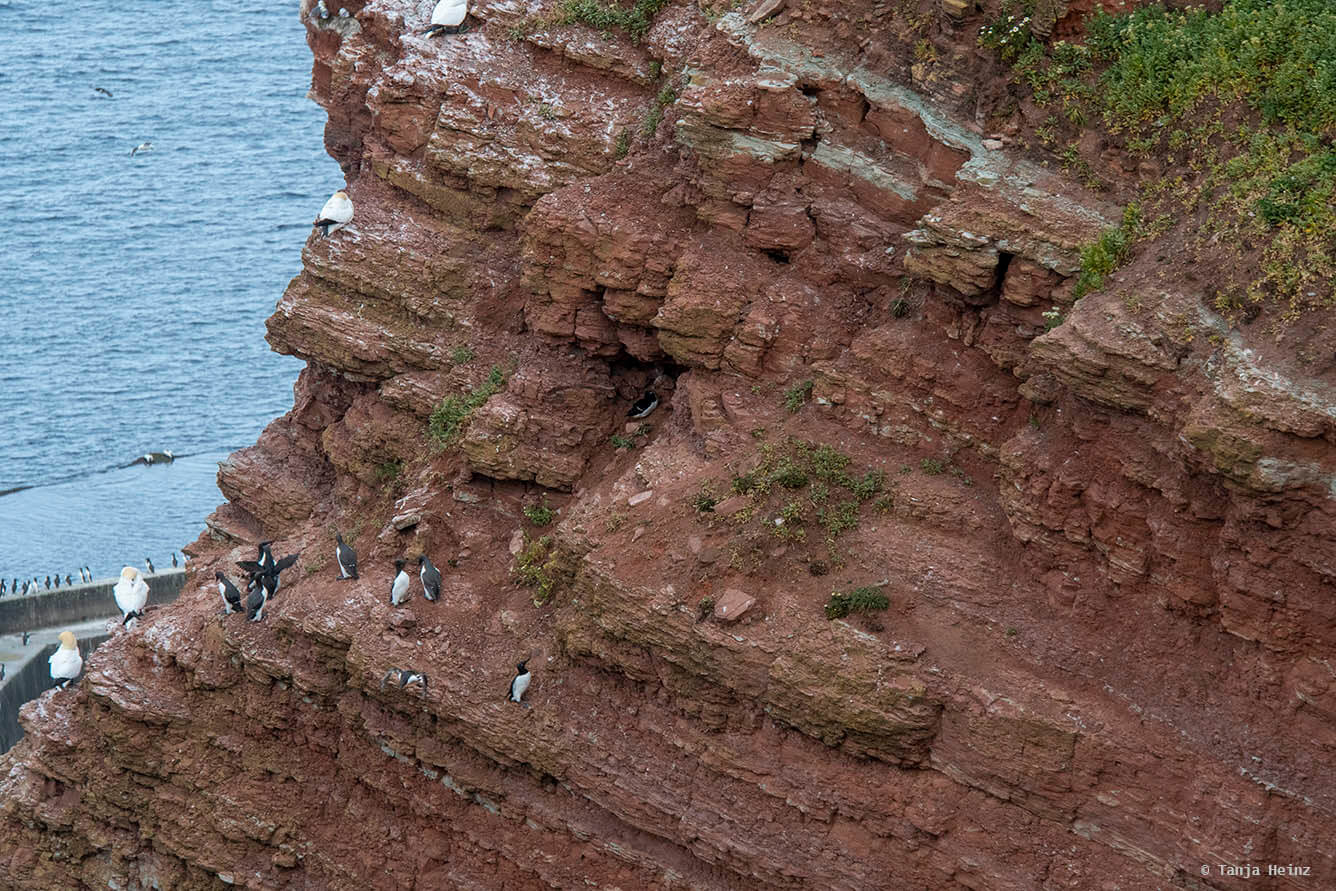
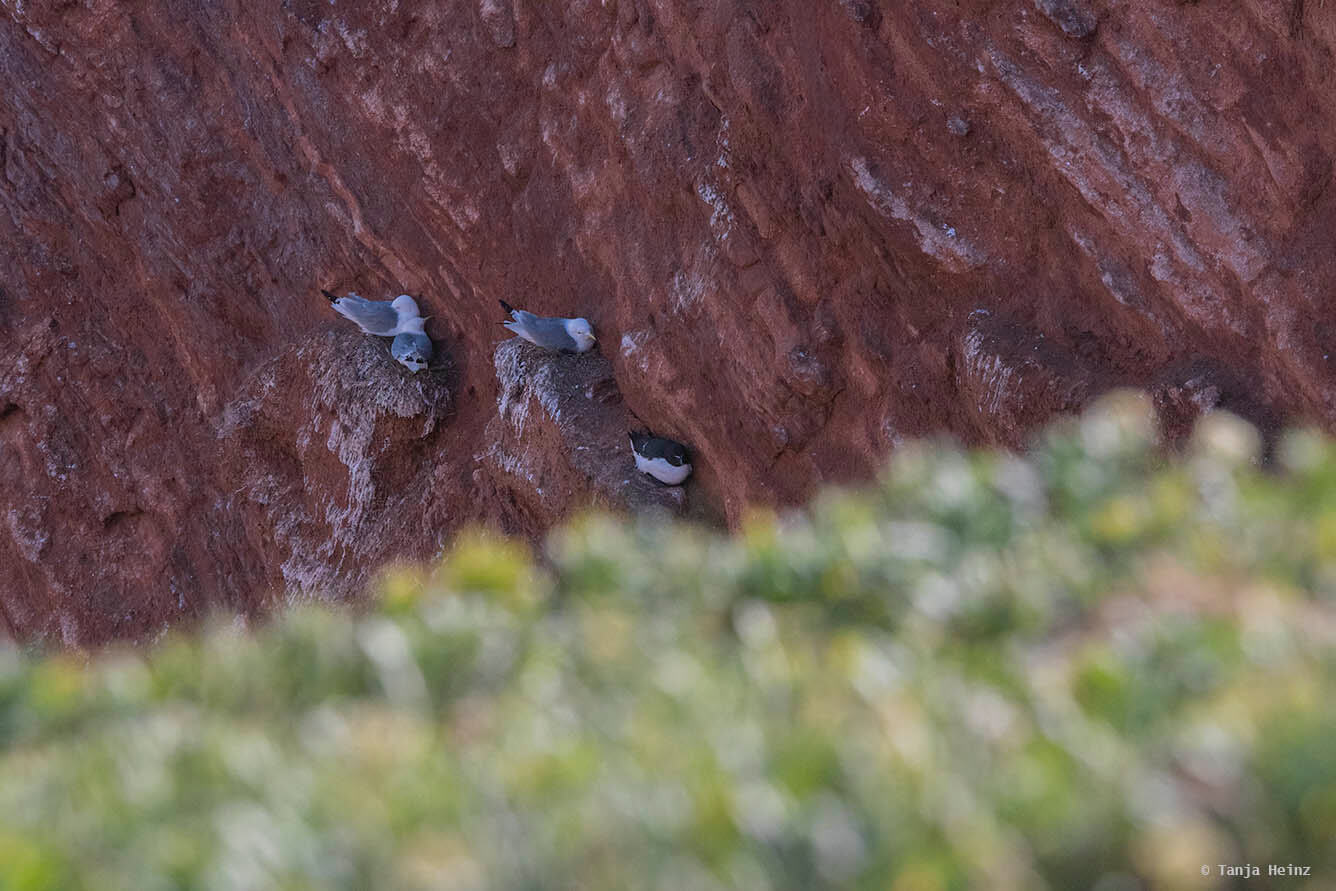
Razorbills live on Heligoland from March to July. They prefer small cavities in the cliffs. That is why I was looking for cavities in the cliffs. Unfortunately, I saw this other couple only on one day. On the other days I could not spot them in their cavity.
Razorbills are like the common guillemots from the auk family. They are "Near Threatened" according to the IUCN and their populations are in a decline. They only live in the North Atlantic, and apparently, they are one of the rarest auks.
Tip: Take some binoculars with you. While northern gannets can be observed from close up on Heligoland, birds like northern fulmars or razorbills are usually further afar. As they are low in numbers, it is easier to spot them with binoculars.
There is one more bird I regularly saw on the Lummenfelsen. The herring gull (Largus argentatus). As they are like black-legged kittiwakes from the family Laridae, it might be easy to oversee them. Usually I saw them sitting, standing, or flying inconspicuously anywhere close-by.
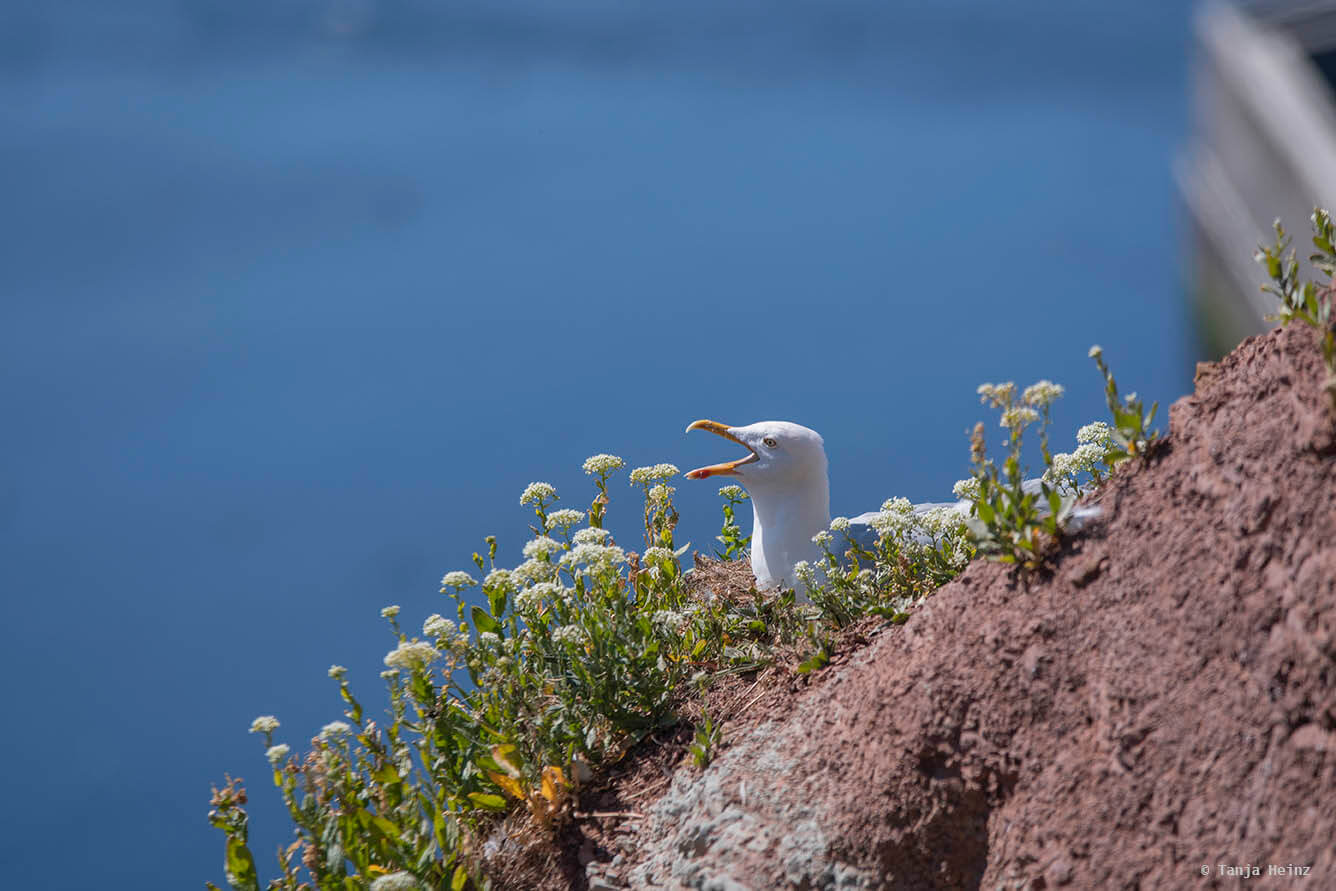
Herring gulls are probably familiar to most people, as they occur at the coasts of many European countries. They even might migrate further inland into cities like Berlin where they find more food. They are of "Least Concern", but their numbers seem to decrease.
There is one more gull species which can be frequently seen on Helgioland, as many lesser black-backed gulls (Larus fuscus) breed on the Helgoländer Düne. On the Helgoländer Düne I was actually looking for harbor seals, but I was quite impressed to see so many of these lesser black-backed gulls breeding on the dunes. Some were more or less hiding behind some vegetation.
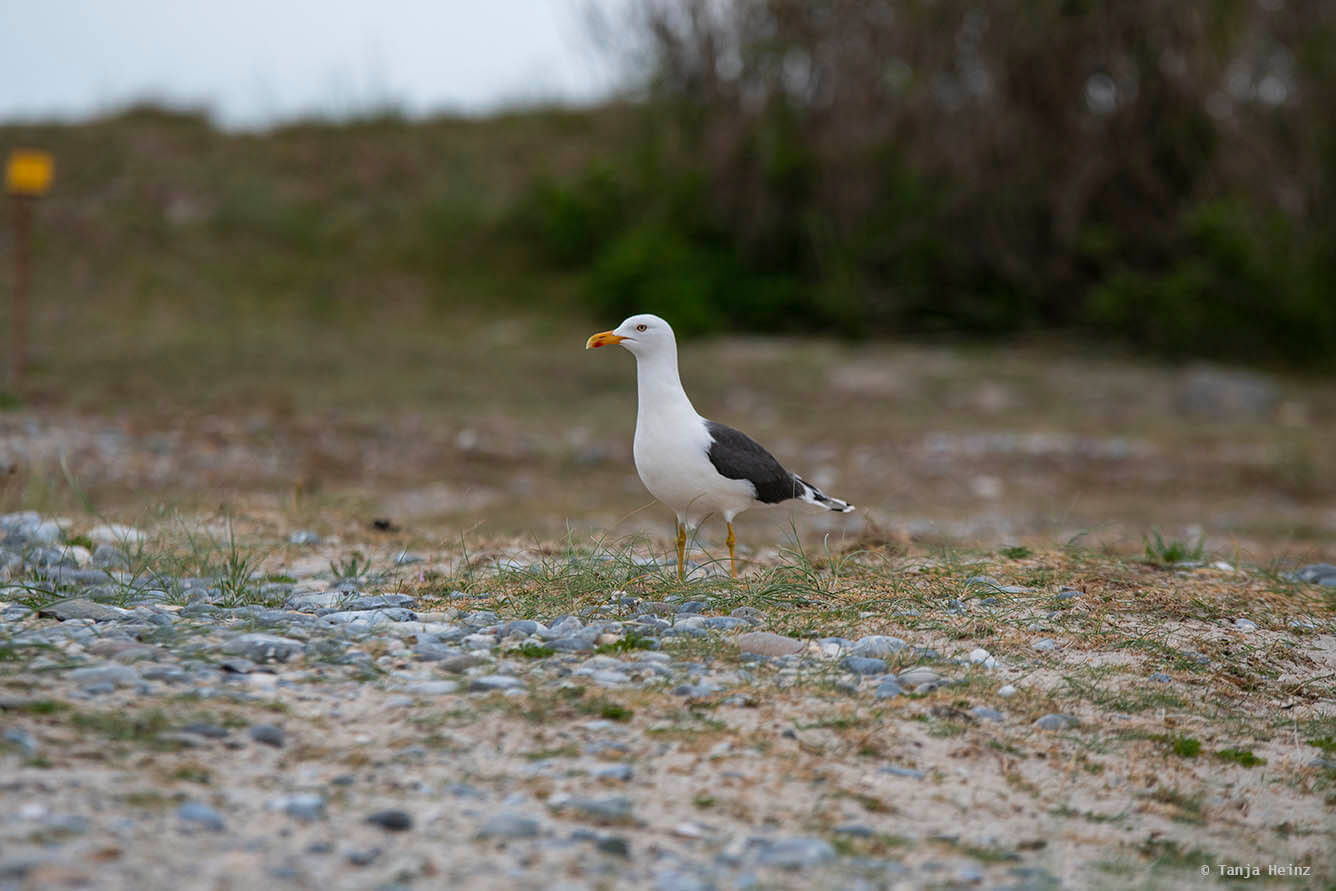

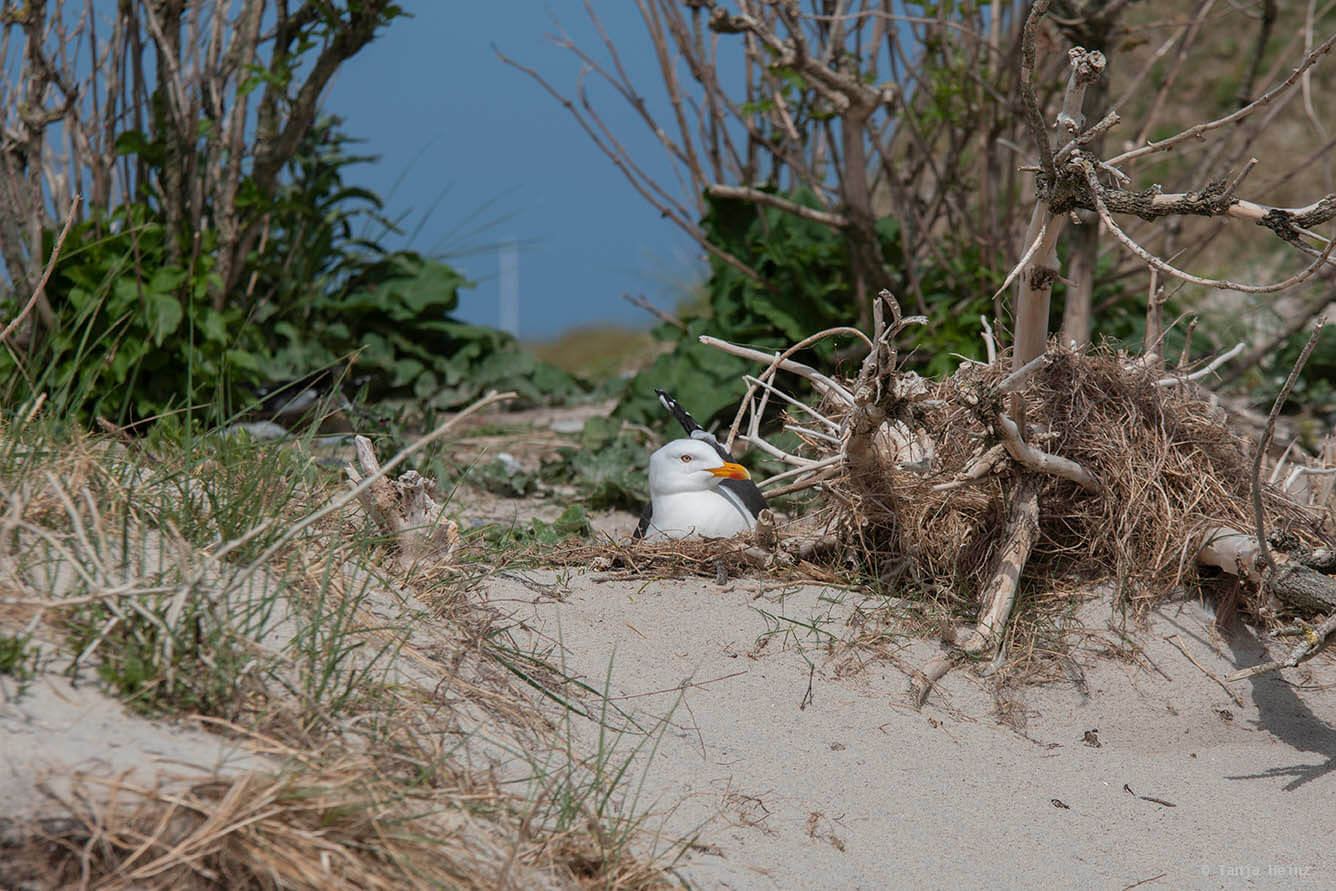
Lesser black-backed gulls are like herring gulls quite similar in appearance, but there are some slight differences. For example, lesser black-backed gulls have yellow legs and they have a much broader distribution extending to Africa and Asia. They are of "Least Concern" and their numbers even seem to increase according to the IUCN.
Important: Please be careful on the Helgoländer Düne and do not disturb the birds, especially while they are breeding. In contrast to northern gannets, lesser black-backed gulls have a much greater flight distance. Do not scare them away from their nests.
Close to the gulls on the Helgoländer Düne I also spotted a greylag goose (Anser anser) with its chicks. As far as I know, greylag geese also breed anywhere on the dunes. They are like the lesser black-backed gulls quite a widespread bird species.
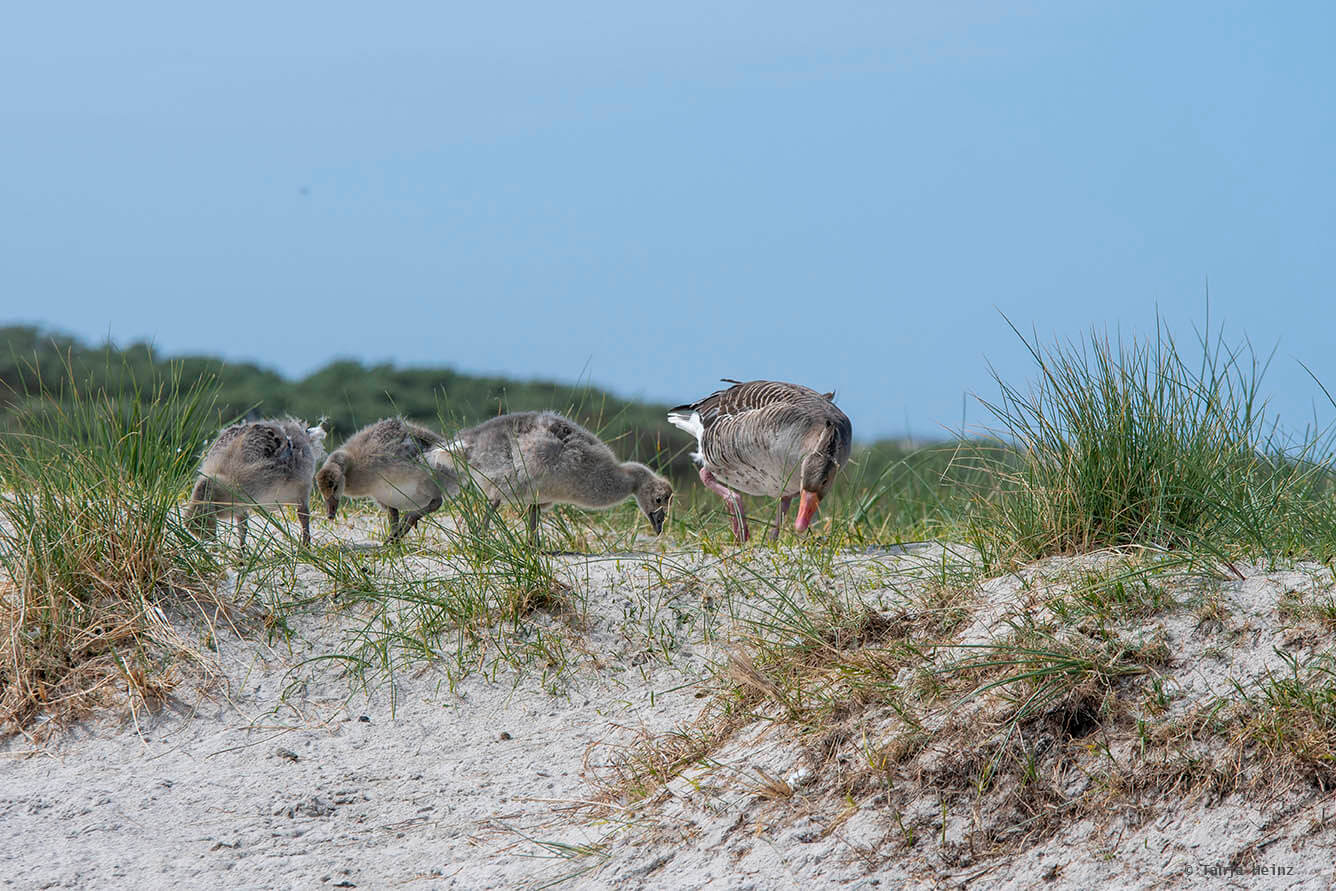
On my last visit in winter I saw one single common eider (Somateria mollissima). In May I saw them several times anywhere on the Helgoländer Düne. Typically, anywhere in groups. Females and males differ in appearance (below on the left: female, below on the right: male).
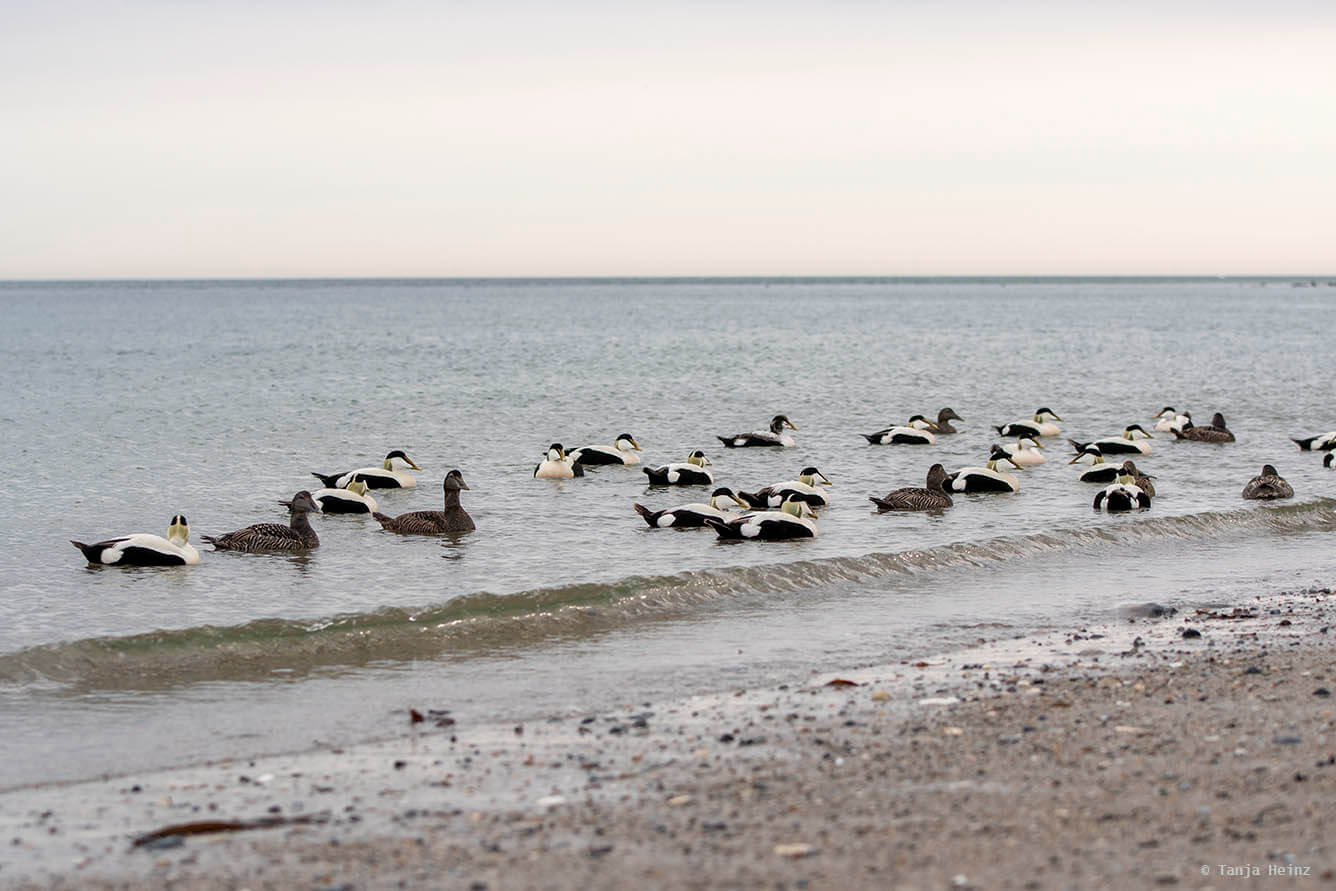
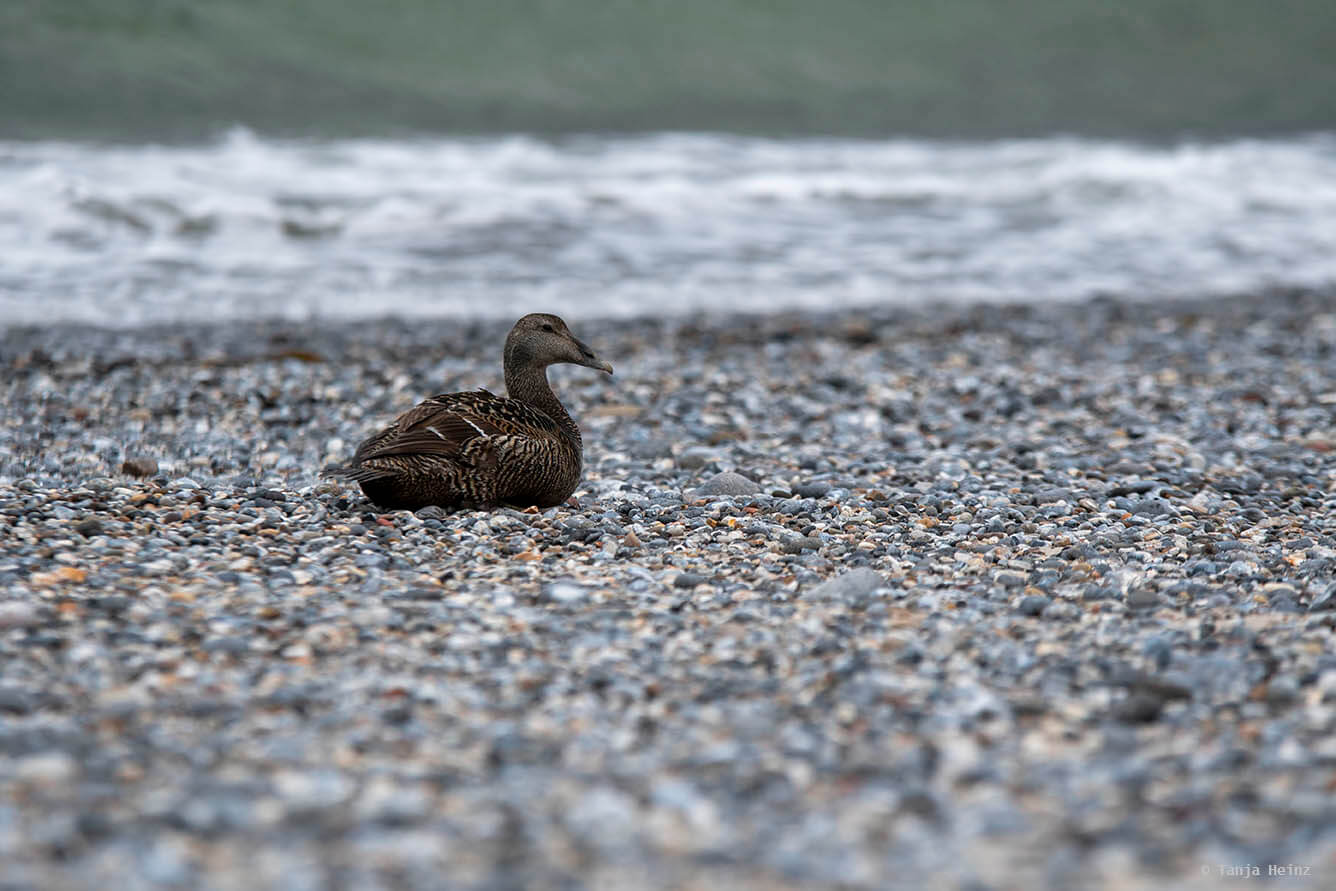
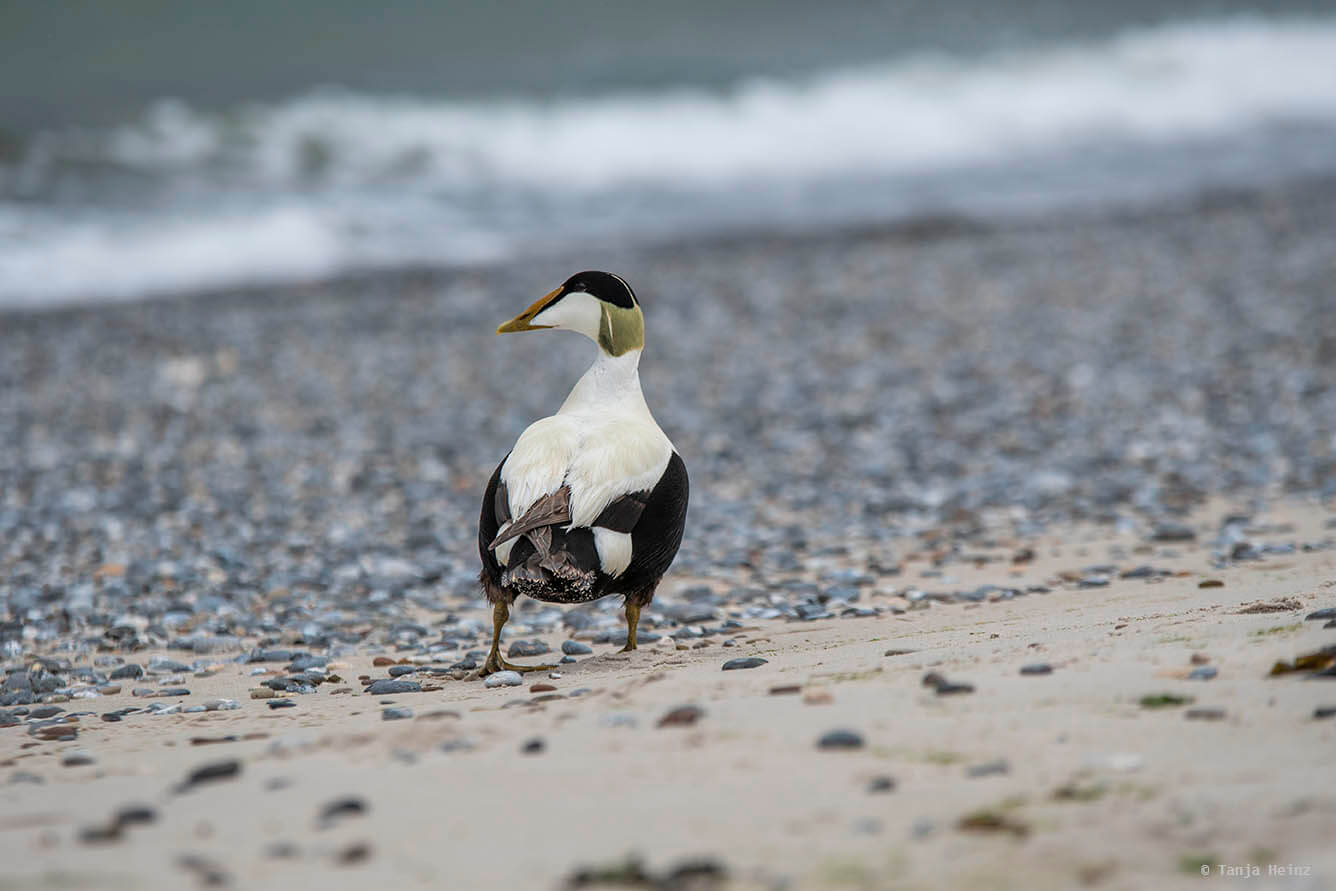
Common eider ducks are not to be confused with other birds due to their characteristic appearance. They are "Near Threatened" according to the IUCN. Its distribution ranges from North America over Europe to eastern Siberia.
I experienced common eider ducks as quite shy. But on the contrary, Eurasian oystercatchers (Haematopus ostralegus) on Heligoland were quite trusting.
In one moment I was sitting on the beach and one oystercatcher was approaching me.
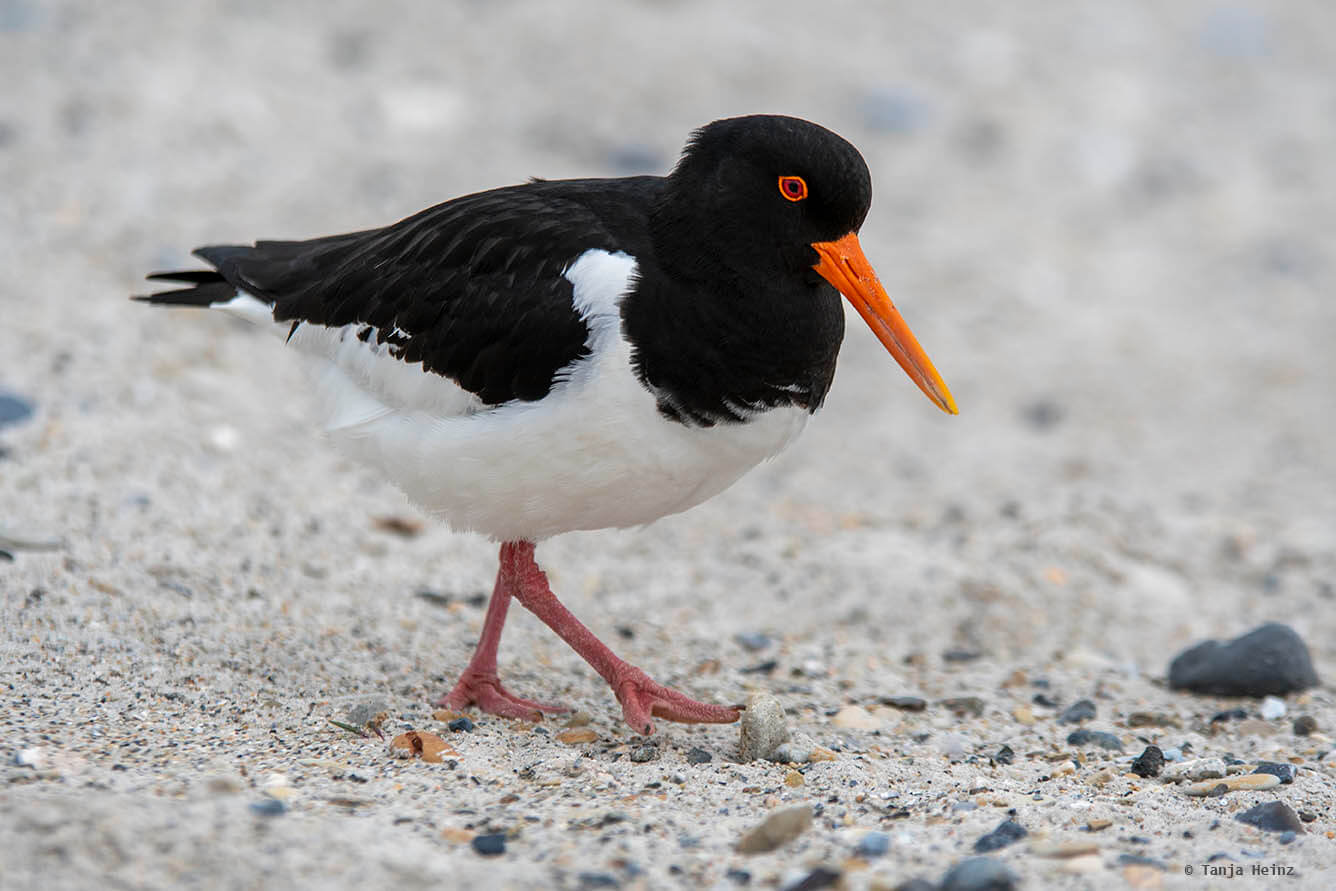
Although Eurasian oystercatchers have a quite wide distribution ranging from Africa over Europe to Asia, they are "Near Threatened" according to the IUCN.
I was very grateful, that this individual was so trusting. Although I was moving with my camera at times, the bird was apparently not frightened.
Northern gannets might be the main attraction for many people, but it is worth to look at all the small birds that might pass by.
In one moment when I was walking to the northern gannets I saw, for example, a common linnet (Linaria cannabina).
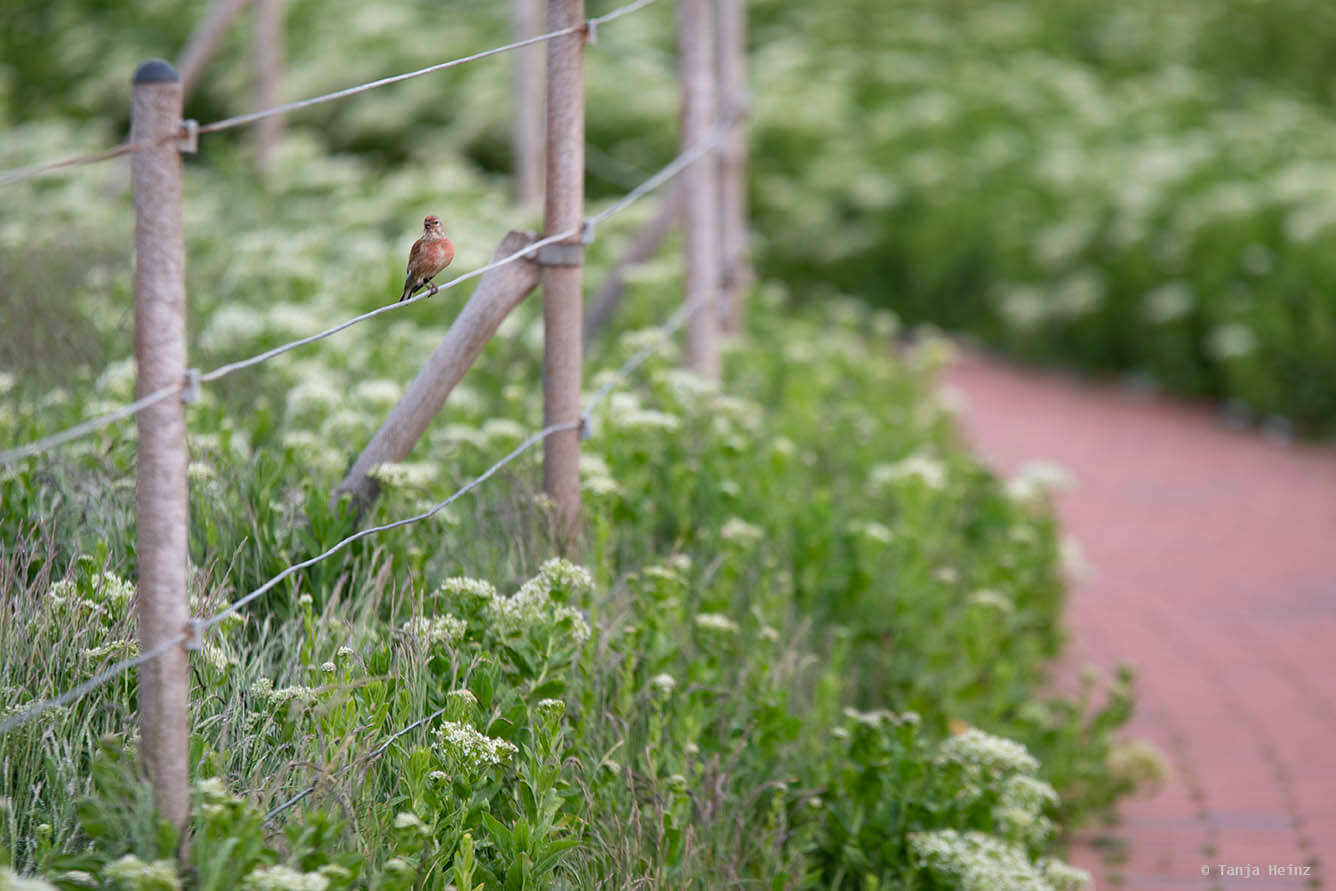
Tip: If you do not know a bird species, try to check iNaturalist or Naturgucker to get help in the identification of a bird. If you know already the bird species, you might want to share your nature observations anyway on the website with other nature lovers.
Harbor seals on the Helgoländer Düne
Although my trip to Heligoland in May was mainly determined by all those birds on the cliffs at the Lummenfelsen or Tall Anna - especially the northern gannets - I also was looking forward to see some more harbor seals. I spotted some single harbor seals already in winter, but I expected to see more of them in May.
And indeed I did see some more of them.
I saw, for example, one single harbor seal on the Nordstrand of the Helgoländer Düne.
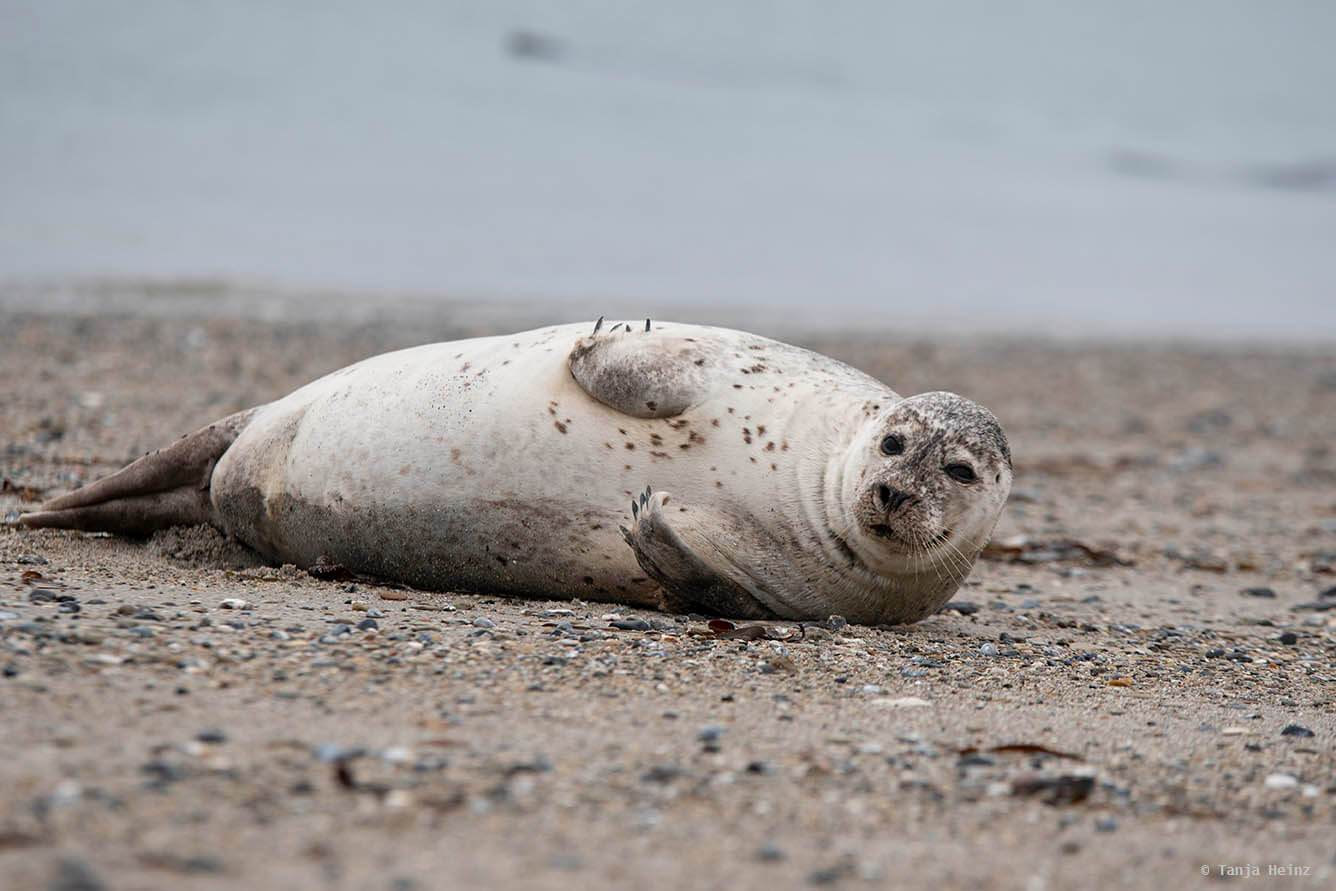
And two separate groups on the Südstrand.
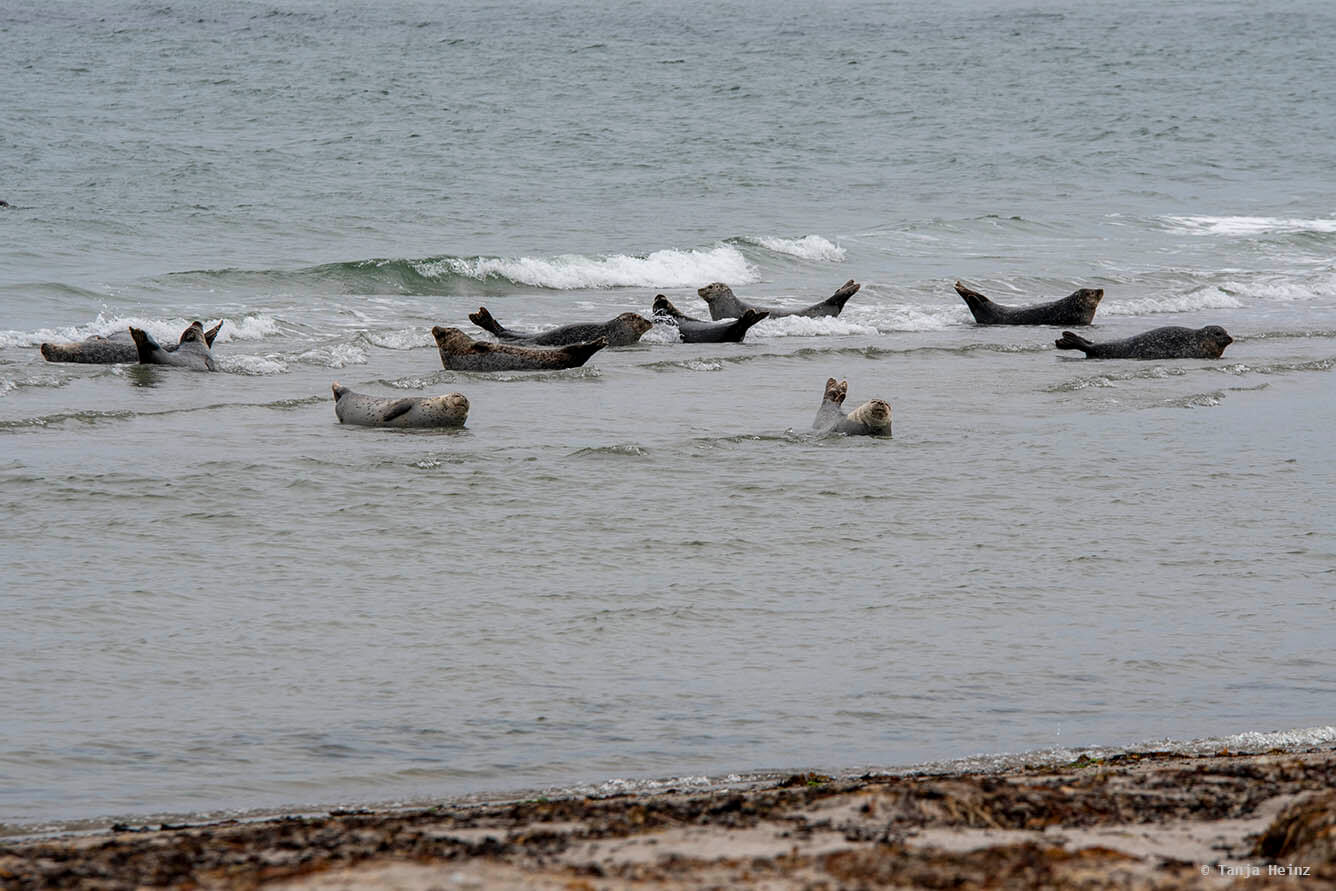
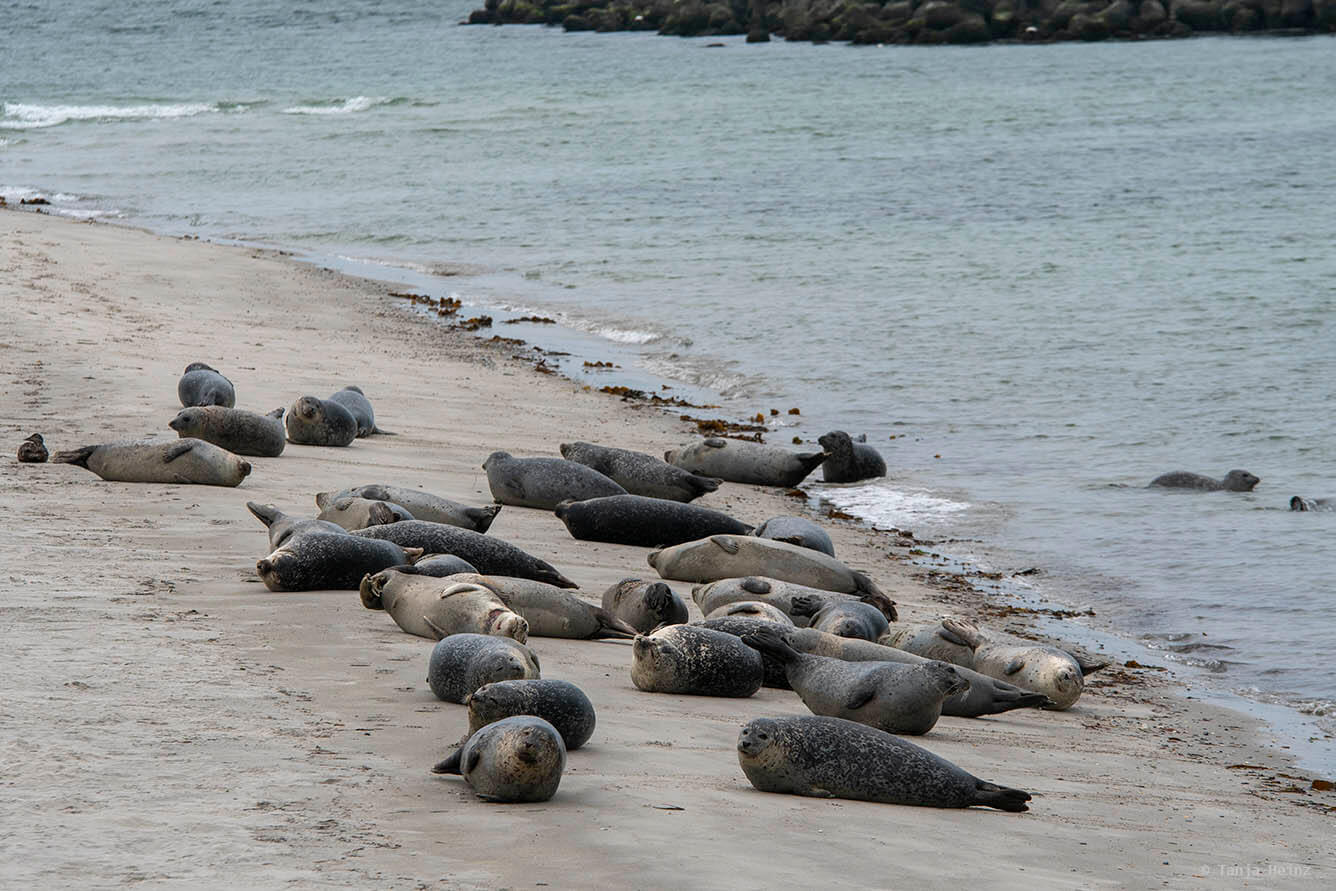
The seals only stay on the Helgoländer Düne. I went to the Helgoländer Düne once on a morning and on another day in the afternoon. I definitely preferred the morning on the dune (although the weather was not that good), as in the afternoon there were many more people around. Maybe because of the cloudy morning and the weather forecast predicting rain for the afternoon why only few people went to the Helgoländer Düne on that morning.
By the way, in May you will not only encounter harbor seals on the beach. You will also spot some grey seals (Halichoerus grypus). Grey seals are the main attraction from November to January, as they give birth to their young in winter on the Helgoländer Düne.
In May I saw several separate grey seal groups along the beach of the Nordstrand. Some were sunbathing. While others were playing in the water.

It was quite amusing to observe them. On the day of my afternoon visit, I was looking for a more or less lonely place to rest in order to observe them for a long time.
Information: If you want to know more about grey seals in winter, please check my previous blog entry about Heligoland in winter by checking the following link.
Harbor seals are frequent visitors in the North Sea like on the Helgoländer Düne, where they share the beach and the waters around the dune with holiday makers.
Every year between June and July harbor seals give birth to their young at low tide on sandbanks. At the next high tide, the young are already able to follow their mothers into the water, because harbor seal pups are very well developed at birth. Just within hours of birth they are able to swim and dive.
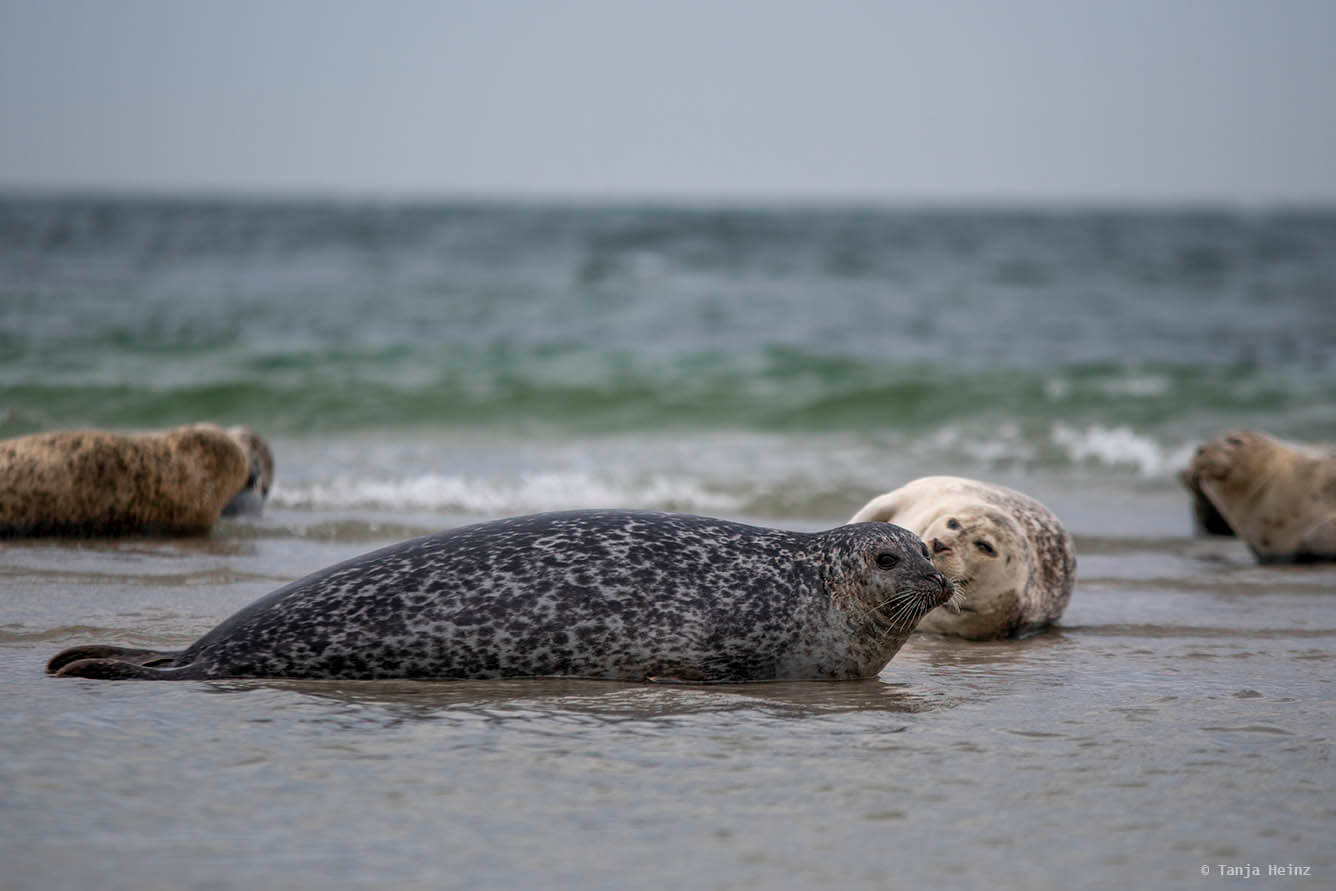
Grey seal pups, in contrast, are born with a silky white fur. They first have to shed their pup fur and grow waterproof adult fur before they can enter the water.
Birthing of harbor seal pups happens annually on shore. Usually, shortly after breeding, adult harbor seals undergo moulting. When moulting, harbor seals have to spent their time on the shore.
Tip: If you are interested to visit the sandbanks with the harbor seals by ship, the company Cassen Eils regularly offers tours. Please check their website to get up-to-date information.

Harbor seals are apparently of "Least Concern", although their population trend worldwide is unkonwn. At least in the Wadden Sea, 40.000 individuals of harbor seals were counted in 2018. Harbor seals, however, are more frequent in the North Sea than in the Baltic Sea.
Tip: If you spot a seal on the beach on the Helgoländer Düne, check its size and head. While harbor seals have a rounded head, grey seals have a rather wide and blunt muzzle.
Citizen Science: Coastwards
Before I come to the end of this blog entry, I would like to pay attention to a citizen science project I have just started to support with my photographs. The name of this citizen science project is Coastwards. Its goal is to create a global map of coasts.
It is easy to participate. You just have to make a photograph of the coast where you are.
I do not live close to a coast. But on my daily walks on the mainland of Heligoland and on the Helgoländer Düne, I was taking photographs for Coastwards.

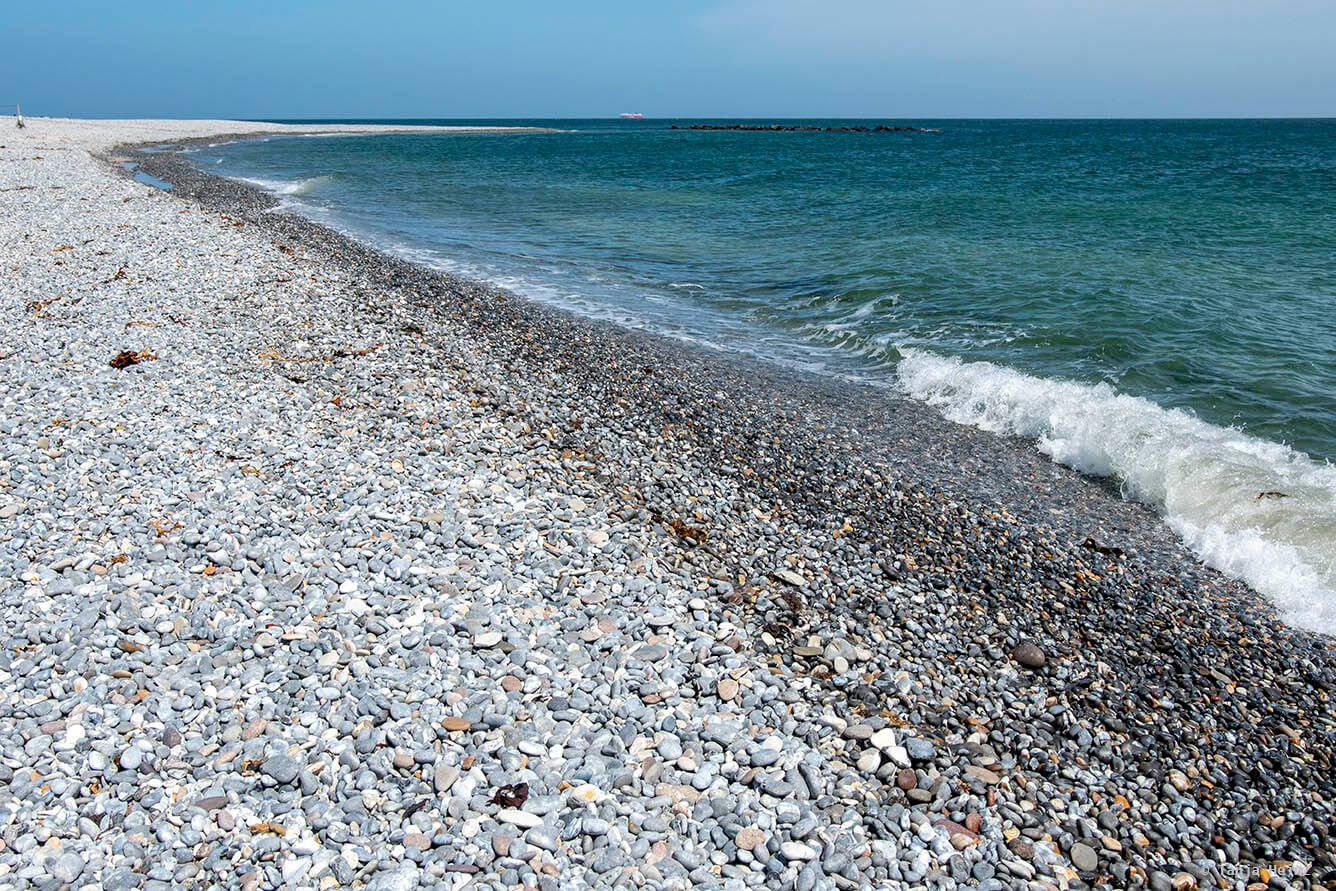
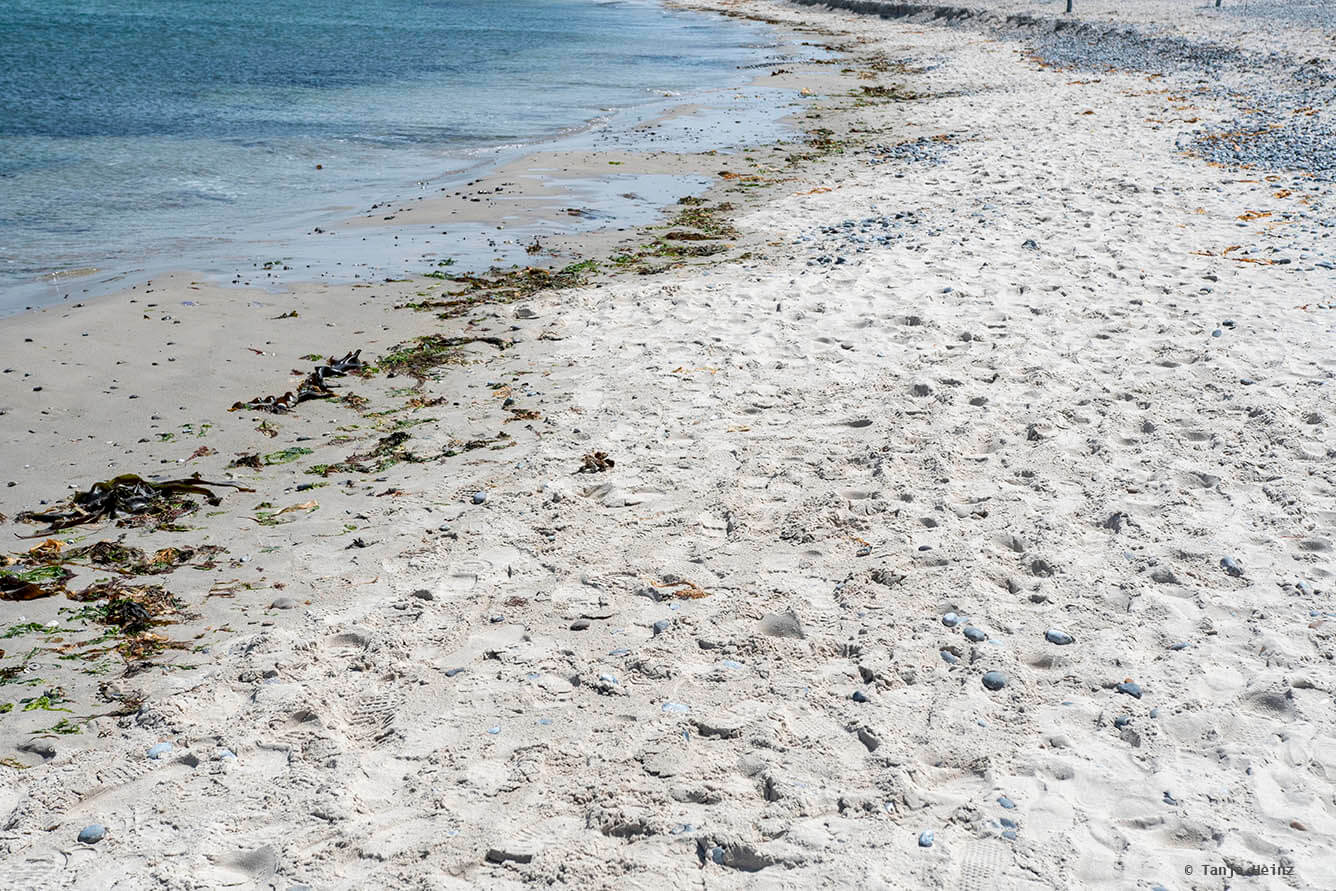
When you take a photograph of a coast, you also should determine the type of coast at that specific location. Is it man-made, ice, rock, mud, pebble, or sand? Then you have to upload the photographs with all your information on the website of the citizen science project. Your photographs will be added to a global map.
The more people participate and share their pictures, the more information they have about which different types of coasts exist at different locations. If there are already photographs of your location, it might be still interesting to share your photographs, as photographs over the months or years might reveal changes of coasts...
Why is this important? What is the aim of this citizen science project?
Well, the researchers of this project intend to use these pictures and the information to make predictions about sea-level rises and they try to answer questions like "How do different coasts react under different circumstances?". Be it man-made or not.
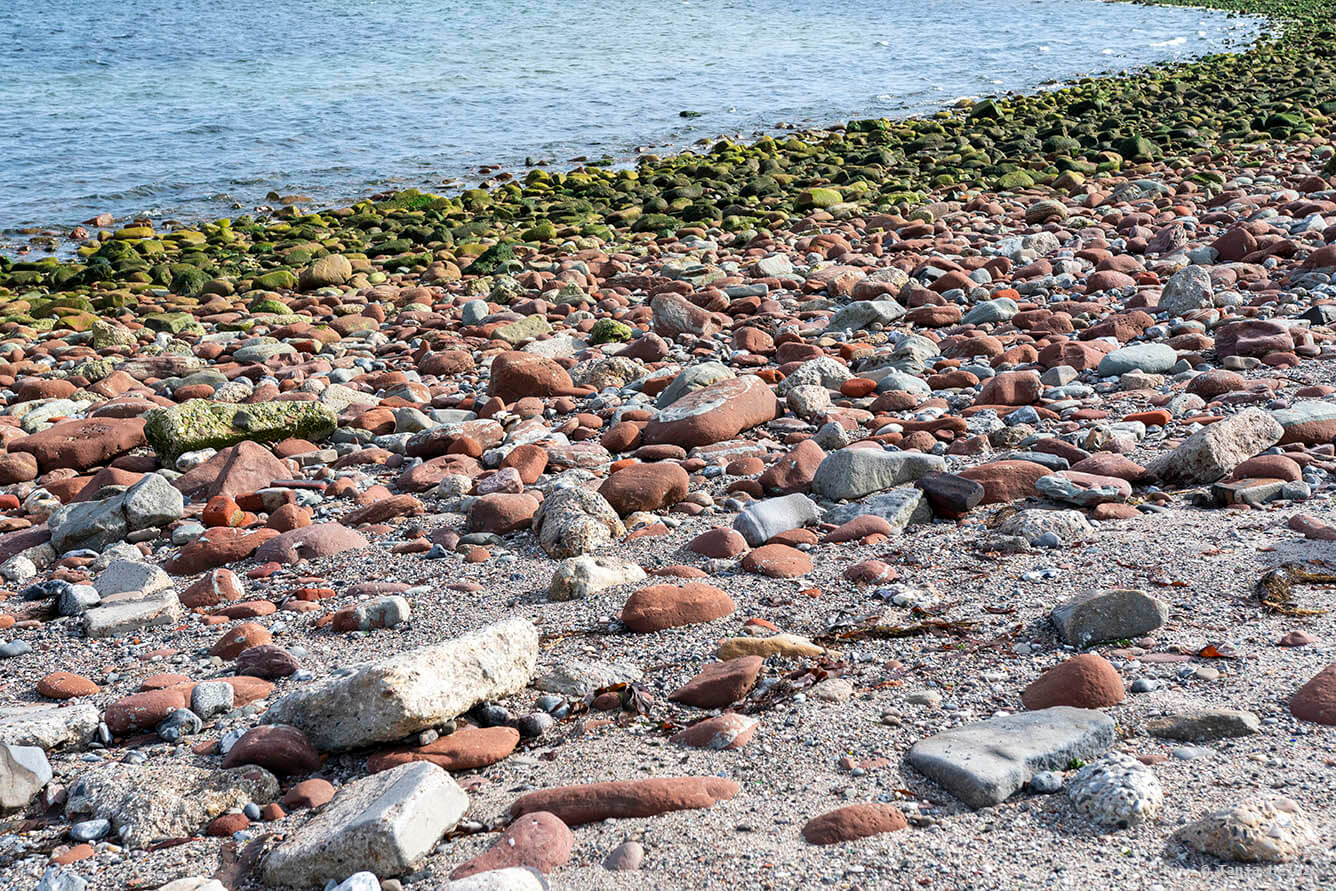
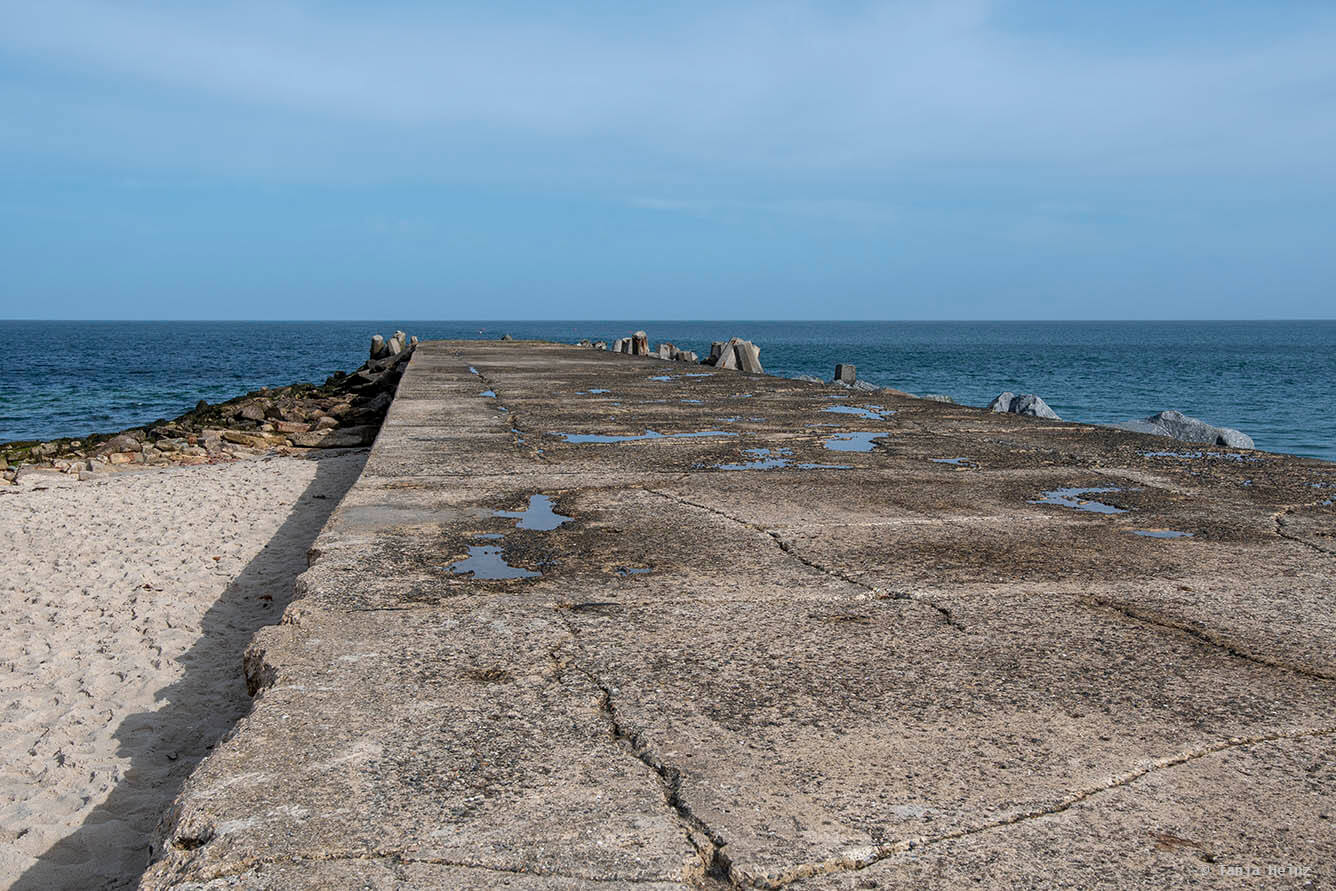
These predictions are important information for national and international policy makers in order to make decisions about all the actions to take to protect our coasts from sea-level rise.
Question: Have you already participated in this citizen science project? If you do have older pictures, you can also contribute them to science. I think it is a good project. It is also interesting to explore coasts on different parts of the world. Or do you know another citizen science project which you would like to share? Please let me and the readers know in the comments.
More information about northern gannets and harbor seals
Bird watching information on the official website of Heligoland (only in German)
Information about seals on the official website of Heligoland (only in German)
Research project northern gannets and marine pollution (only in German)
Wikipedia about northern gannets
Birdlife about northern gannets
More about the harbor seals in the Wadden Sea (only in German)
Article about Coastwards on GEO (only in German)
Official website of Coastwards
Coastwards on Bürger schaffen Wissen (only in German)
Have you already been on Heligoland to see northern gannets? Which birds or other wildlife have you seen? Please let me know in the comments.
